| 2018 | 2017 | 2016 | 2015 | 2014 | 2013 | 2012 | 2011 | 2010 | 2009 | 2008 | 2007 | 2006 | 2005 | 2004 | 2004 > |
Learnt knot placement in B-spline curve approximation using support vector machines
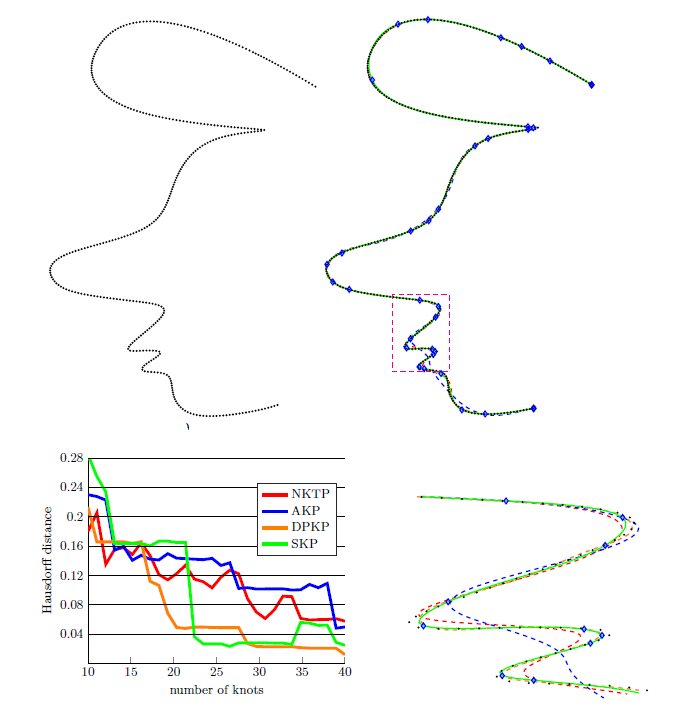
In: Computer Aided Geometric Design, 62: 104-116, 2018.
Knot placement for curve
approximation is a well known and yet open problem in
geometric modeling. Selecting knot values that yield good
approximations is a challenging task, based largely on
heuristics and user experience. More advanced approaches
range from parametric averaging to genetic algorithms.
In this paper, we propose to use Support Vector Machines (SVMs) to determine suitable knot vectors for B-spline curve approximation. The SVMs are trained to identify locations in a sequential point cloud where knot placement will improve the approximation error. After the training phase, the SVM can assign, to each point set location, a so-called score. This score is based on geometric and differential geometric features of points. It measures the quality of each location to be used as knots in the subsequent approximation. From these scores, the final knot vector can be constructed exploring the topography of the score vector without the need for iteration or optimization in the approximation process. Knot vectors computed with our approach outperform state of the art methods and yield tighter approximations.
In this paper, we propose to use Support Vector Machines (SVMs) to determine suitable knot vectors for B-spline curve approximation. The SVMs are trained to identify locations in a sequential point cloud where knot placement will improve the approximation error. After the training phase, the SVM can assign, to each point set location, a so-called score. This score is based on geometric and differential geometric features of points. It measures the quality of each location to be used as knots in the subsequent approximation. From these scores, the final knot vector can be constructed exploring the topography of the score vector without the need for iteration or optimization in the approximation process. Knot vectors computed with our approach outperform state of the art methods and yield tighter approximations.
Available formats: pdf
Citation: BibTeX
Evaluation of Features for SVM-based Classification of Geometric Primitives in Point Clouds
Laube, Franz, Umlauf
In: 15th IAPR International Conference on Machine Vision Applications (MVA), 15, 2017.
In the reverse engineering process one has to classify parts of point clouds with the correct type of geometric primitive. Features based on different geometric properties like point relations, normals, and curvature information can be used to train classifiers like Support Vector Machines (SVM). These geometric features are estimated in the local neighborhood of a point of the point cloud. The multitude of different features makes an in-depth comparison necessary. In this work we evaluate 23 features for the classification of geometric primitives in point clouds. Their performance is evaluated on SVMs when used to classify geometric primitives in simulated and real laser scanned point clouds. We also introduce a normalization of point cloud density to improve classification generalization.
In: 15th IAPR International Conference on Machine Vision Applications (MVA), 15, 2017.
In the reverse engineering process one has to classify parts of point clouds with the correct type of geometric primitive. Features based on different geometric properties like point relations, normals, and curvature information can be used to train classifiers like Support Vector Machines (SVM). These geometric features are estimated in the local neighborhood of a point of the point cloud. The multitude of different features makes an in-depth comparison necessary. In this work we evaluate 23 features for the classification of geometric primitives in point clouds. Their performance is evaluated on SVMs when used to classify geometric primitives in simulated and real laser scanned point clouds. We also introduce a normalization of point cloud density to improve classification generalization.
Available formats: pdf
Citation: BibTeX
Radiometric calibration of digital cameras using neural networks
Grunwald, Laube, Schall, Umlauf, Franz
In: Conference: Optics and Photonics for Information Processing XI.
Digital cameras ar
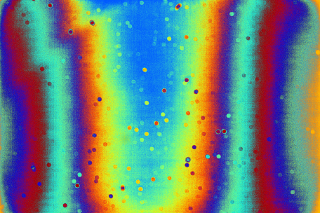 e used
in a large variety of scientific and industrial
applications. For most applications, the acquired data
should represent the real light intensity per pixel as
accurately as possible. However, digital cameras are
subject to physical, electronic and optical effects that
lead to errors and noise in the raw image.
Temperature-dependent dark current, read noise, optical
vignetting or different sensitivities of individual
pixels are examples of such effects. The purpose of
radiometric calibration is to improve the quality of the
resulting images by reducing the influence of the
various types of errors on the measured data and
thus improving the quality of the overall
application. In this context, we present a specialized
neural network architecture for radiometric calibration
of digital cameras. Neural networks are used to learn a
temperature- and exposure-dependent mapping from
observed gray-scale values to true light intensities for
each pixel. In contrast to classical flat-fielding,
neural networks have the potential to model nonlinear
mappings which allows for accurately capturing the
temperature dependence of the dark current and for
modeling cameras with nonlinear sensitivities. Both
scenarios are highly relevant in industrial
applications. The experimental comparison of our network
approach to classical flat-fielding shows a consistently
higher reconstruction quality, also for linear cameras.
In addition, the calibration is faster than previous
machine learning approaches based on Gaussian processes.
e used
in a large variety of scientific and industrial
applications. For most applications, the acquired data
should represent the real light intensity per pixel as
accurately as possible. However, digital cameras are
subject to physical, electronic and optical effects that
lead to errors and noise in the raw image.
Temperature-dependent dark current, read noise, optical
vignetting or different sensitivities of individual
pixels are examples of such effects. The purpose of
radiometric calibration is to improve the quality of the
resulting images by reducing the influence of the
various types of errors on the measured data and
thus improving the quality of the overall
application. In this context, we present a specialized
neural network architecture for radiometric calibration
of digital cameras. Neural networks are used to learn a
temperature- and exposure-dependent mapping from
observed gray-scale values to true light intensities for
each pixel. In contrast to classical flat-fielding,
neural networks have the potential to model nonlinear
mappings which allows for accurately capturing the
temperature dependence of the dark current and for
modeling cameras with nonlinear sensitivities. Both
scenarios are highly relevant in industrial
applications. The experimental comparison of our network
approach to classical flat-fielding shows a consistently
higher reconstruction quality, also for linear cameras.
In addition, the calibration is faster than previous
machine learning approaches based on Gaussian processes.Citation: BibTeX
A short survey on recent methods for cage computation
Laube, Umlauf
In: BW-CAR| SINCOM, pp. 37, 2016.
Creating cages that enclose
a 3D-model of some sort is part of many preprocessing
pipelines in computational geometry. Creating a cage
of preferably lower resolution than the original model
is of special interest when performing an operation on
the original model might be to costly. The desired
operation can be applied to the cage first and then
transferred to the enclosed model. With this paper the
authors present a short survey of recent and well
known methods for cage computation. The authors would
like to give the reader an insight in common methods
and their differences.
Available formats: pdf
Citation: BibTeX
Support vector machines for classification of geometric primitives in point clouds
Caputo, Denker, Franz, Laube, Umlauf
In: Boissonnat, et al. (eds): Curves and Surfaces, Springer, 80-95, 2015.
Classification of point clouds by
different types of geometric primitives is an
essential part in the reconstruction process of CAD
geometry. We use support vector machines (SVM) to
label patches in point clouds with the class labels
tori, ellipsoids, spheres, cones, cylinders or planes.
For the classification, features based on different
geometric properties like point normals, angles, and
principal curvatures are used. These geometric
features are estimated in the local neighborhood of a
point of the point cloud. Computing these geometric
features for a random subset of the point cloud yields
a feature distribution. Different features are
combined for achieving best classification results. To
minimize the time consuming training phase of SVMs,
the geometric features are first evaluated using
linear discriminant analysis (LDA).
LDA and SVM are machine learning approaches that require an initial training phase to allow for a subsequent automatic classification of a new data set. For the training phase point clouds are generated using a simulation of a laser scanning device. Additional noise based on an laser scanner error model is added to the point clouds. The resulting LDA and SVM classifiers are then used to classify geometric primitives in simulated and real laser scanned point clouds. Compared to other approaches, where all known features are used for classification, we explicitly compare novel against known geometric features to prove their effectiveness.
Available formats: pdfLDA and SVM are machine learning approaches that require an initial training phase to allow for a subsequent automatic classification of a new data set. For the training phase point clouds are generated using a simulation of a laser scanning device. Additional noise based on an laser scanner error model is added to the point clouds. The resulting LDA and SVM classifiers are then used to classify geometric primitives in simulated and real laser scanned point clouds. Compared to other approaches, where all known features are used for classification, we explicitly compare novel against known geometric features to prove their effectiveness.
Citation: BibTeX
On-line CAD reconstruction with accumulated means of local geometric properties
Denker, Hamann, Umlauf
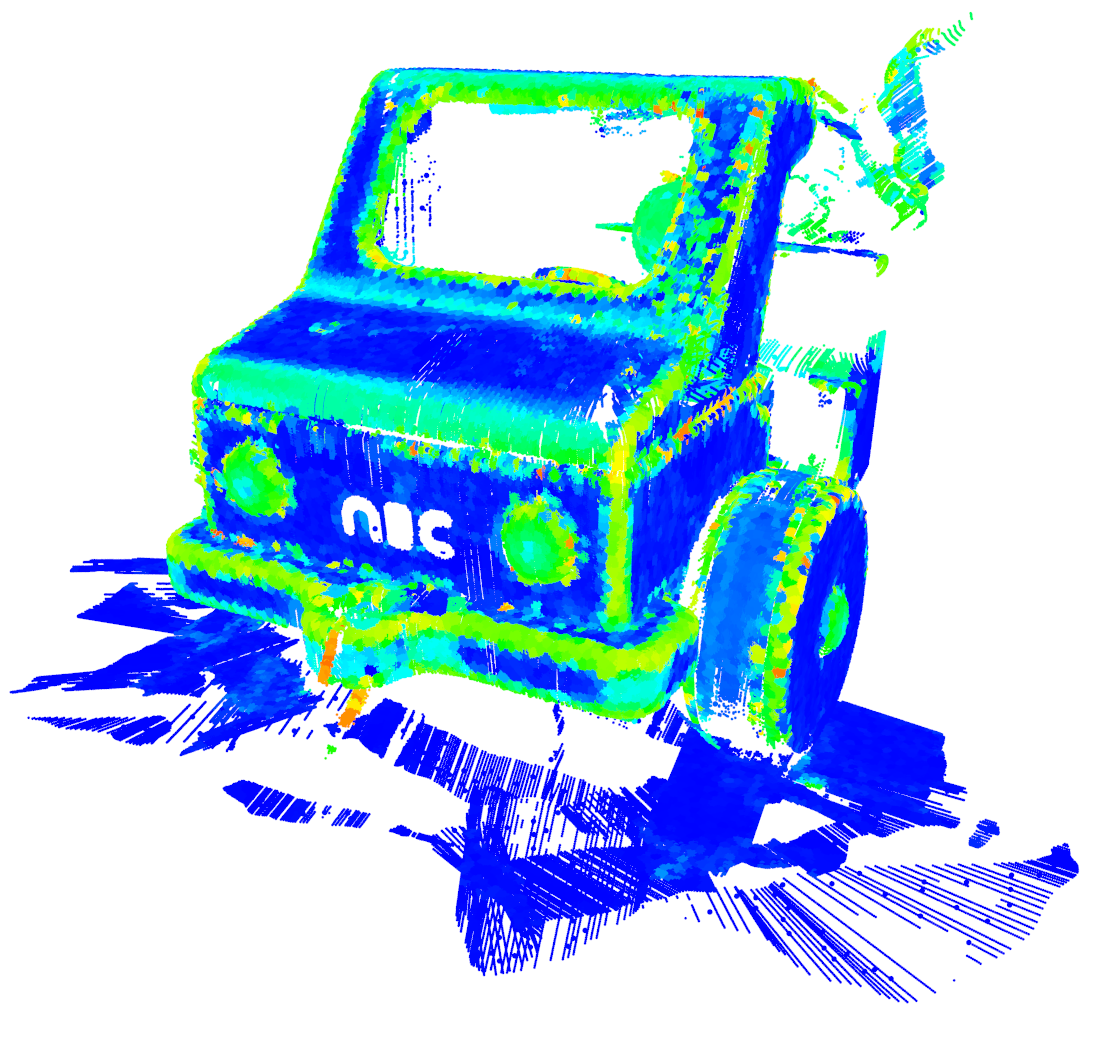
Reconstruction of hand-held laser scanner
data is used in industry primarily for reverse
engineering. Traditionally, scanning and
reconstruction are separate steps. The
operator of the laser scanner h as no feedback from
the reconstruction results. On-line reconstruction of
the CAD geometry allows for such an immediate
feedback.
We propose a method for on-line segmentation and reconstruction of CAD geometry from a stream of point data based on means that are updated on-line. These means are combined to define complex local geometric properties, e.g., to radii and center points of spherical regions. Using means of local scores, planar, cylindrical, and spherical segments are detected and extended robustly with region growing. For the on-line computation of the means we use so-called accumulated means. They allow for on-line insertion and removal of values and merging of means. Our results show that this approach can be performed on-line and is robust to noise. We demonstrate that our method reconstructs spherical, cylindrical, and planar segments on real scan data containing typical errors caused by hand-held laser scanners.
Available formats: pdfWe propose a method for on-line segmentation and reconstruction of CAD geometry from a stream of point data based on means that are updated on-line. These means are combined to define complex local geometric properties, e.g., to radii and center points of spherical regions. Using means of local scores, planar, cylindrical, and spherical segments are detected and extended robustly with region growing. For the on-line computation of the means we use so-called accumulated means. They allow for on-line insertion and removal of values and merging of means. Our results show that this approach can be performed on-line and is robust to noise. We demonstrate that our method reconstructs spherical, cylindrical, and planar segments on real scan data containing typical errors caused by hand-held laser scanners.
Citation: BibTeX
Radiometric calibration of digital cameras using Gaussian processes
Schall, Grunwald, Umlauf, Franz
In: SPIE, 2015.
Digital cameras are subject to physical,
electronic and optic effects that result in errors and
noise in the image. These effects include for example
a temperature dependent dark current, read noise,
optical vignetting or different sensitivities of
individual pixels. The task of a radiometric
calibration is to reduce these errors in the image and
thus improve the quality of the overall application.
In this work we present an algorithm for radiometric
calibration based on Gaussian processes. Gaussian
processes are a regression method widely used in
machine learning that is particularly useful in our
context. Then Gaussian process regression is used to
learn a temperature and exposure time dependent
mapping from observed gray-scale values to true light
intensities for each pixel.
Regression models based on the characteristics of single pixels suffer from excessively high runtime and thus are unsuitable for many practical applications. In contrast, a single regression model for an entire image with high spatial resolution leads to a low quality radiometric calibration, which also limits its practical use. The proposed algorithm is predicated on a partitioning of the pixels such that each pixel partition can be represented by one single regression model without quality loss. Partitioning is done by extracting features from the characteristic of each pixel and using them for lexicographic sorting. Splitting the sorted data into partitions with equal size yields the final partitions, each of which is represented by the partition centers. An individual Gaussian process regression and model selection is done for each partition. Calibration is performed by interpolating the gray-scale value of each pixel with the regression model of the respective partition. The experimental comparison of the proposed approach to classical flat field calibration shows a consistently higher reconstruction quality for the same overall number of calibration frames.
Regression models based on the characteristics of single pixels suffer from excessively high runtime and thus are unsuitable for many practical applications. In contrast, a single regression model for an entire image with high spatial resolution leads to a low quality radiometric calibration, which also limits its practical use. The proposed algorithm is predicated on a partitioning of the pixels such that each pixel partition can be represented by one single regression model without quality loss. Partitioning is done by extracting features from the characteristic of each pixel and using them for lexicographic sorting. Splitting the sorted data into partitions with equal size yields the final partitions, each of which is represented by the partition centers. An individual Gaussian process regression and model selection is done for each partition. Calibration is performed by interpolating the gray-scale value of each pixel with the regression model of the respective partition. The experimental comparison of the proposed approach to classical flat field calibration shows a consistently higher reconstruction quality for the same overall number of calibration frames.
Available formats: pdf
Citation: BibTeX
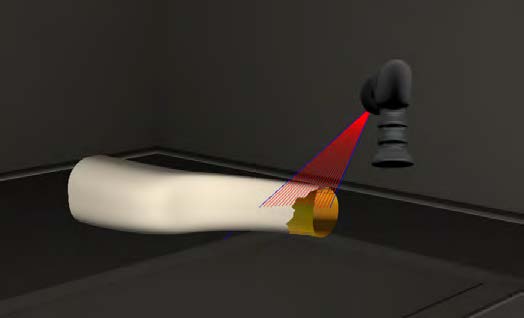 A Virtual-Reality 3d-Laser-Scan Simulation
A Virtual-Reality 3d-Laser-Scan SimulationDanhof, Schneider, Laube, Umlauf
In: BW-CAR Symposium on Information and Communication Systems (SInCom) 2, pp. 68, 2015.
We present a
3d-laser-scan simulation in virtual
reality for creating synthetic scans of CAD models.
Consisting of the virtual reality
head-mounted display Oculus Rift
and the motion controller
Razer Hydra our system can
be used like common hand-held
3d laser scanners. It
supports scanning of triangular
meshes as well as b-spline
tensor product surfaces based on
high performance ray-casting
algorithms. While point clouds of known
scanning simulations are missing the man-made
structure, our approach
overcomes this problem by
imitating real scanning scenarios.
Calculation speed, interactivity
and the resulting realistic point
clouds are the benefits of this
system.
Available formats: pdf
Citation: BibTeX
Pixel-wise Hybrid Image Registration on Wood Decors
Grunwald, Müller, Schall, Laube, Umlauf, Franz
In: BW-CAR Symposium on Information and Communication Systems (SInCom) 2, pp. 24, 2015.
The detection of
differences between images of a
printed reference and a reprinted wood decor often
requires an initial image registration
step. Depending on the
digitization method, the reprint will be displaced and
rotated with respect to the reference. The aim of
registration is to match the images as precisely as
possible. In our approach, images are first matched
globally by extracting feature
points from both images and
finding corresponding point pairs using the RANSAC
algorithm. From these correspondences,
we compute a global projective
transformation between both
images. In order to get
a pixel-wise registration, we
train a learning machine
on the point correspondences found by
RANSAC. The learning algorithm (in our case
Gaussian process regression) is
used to non-linearly interpolate
between the feature points
which results in a high
precision mage registration method
on wood decors.
Available formats: pdf
Citation: BibTeX
Merging multiple 3d face reconstructions
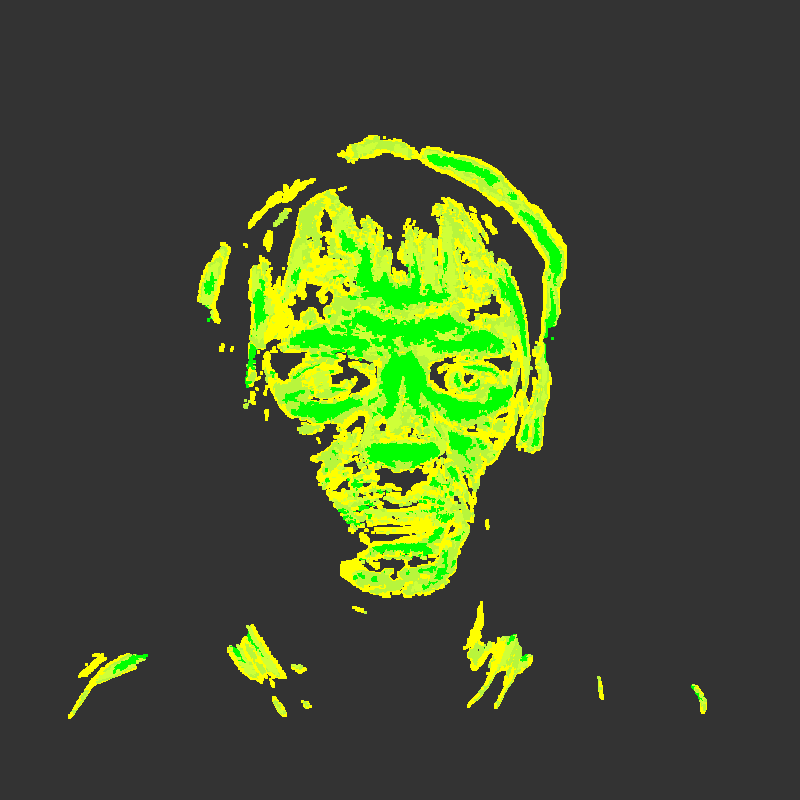
Thießen, Laube, Franz, Umlauf
In: Symposium on Information and Communication Systems, 2014.
In this paper we present a method to merge
multiple 3D face reconstructions into one common
reconstruction of higher quality. The individual
three-dimensional face reconstructions are computed by
a multi-camera stereo-matching system from different
perspectives. Using 4-Points Congruent Sets and
Iterative Closest Point the individual reconstructions
are registered. Then, the registered reconstructions
are merged based on point distance and reconstruction
tenacity. To optimize the parameters in the merging
step a kernel-based point cloud filter is used.
Finally, this filter is applied to smooth the merged
reconstruction. With this approach we are able to fill
holes in the individual reconstruction and improve the
overall visual quality.
Available formats: pdf
Citation: BibTeX
Learning geometric primitives in point clouds
Caputo, Denker, Franz, Laube, Umlauf
In: Symposium on Geometry Processing 2014, EuroGraphics, extended Abstract.
Primitive recognition in 3D point clouds
is an important aspect in reverse engineering. We
propose a method for primitive recognition based on
machine learning approaches. The machine learning
approaches used for the classification are linear
discriminant analysis (LDA) and multi-class support
vector machines (SVM). For the classification process
local geometric properties (features) of the point
cloud are computed based on point relations, normals,
and principal curvatures. For the training phase point
clouds are generated using a simulation of a laser
scanning device based on ray tracing with an error
model. The classification rates of novel, curvature
based geometric features are compared to known
geometric features to prove the effectiveness of the
approach.
Available formats: pdf
Citation: BibTeX
On-line reconstruction of CAD geometry
Denker, Hagel, Raible, Umlauf, Hamann
In: International Conference on 3D Vision 2013, IEEE, 151-158.
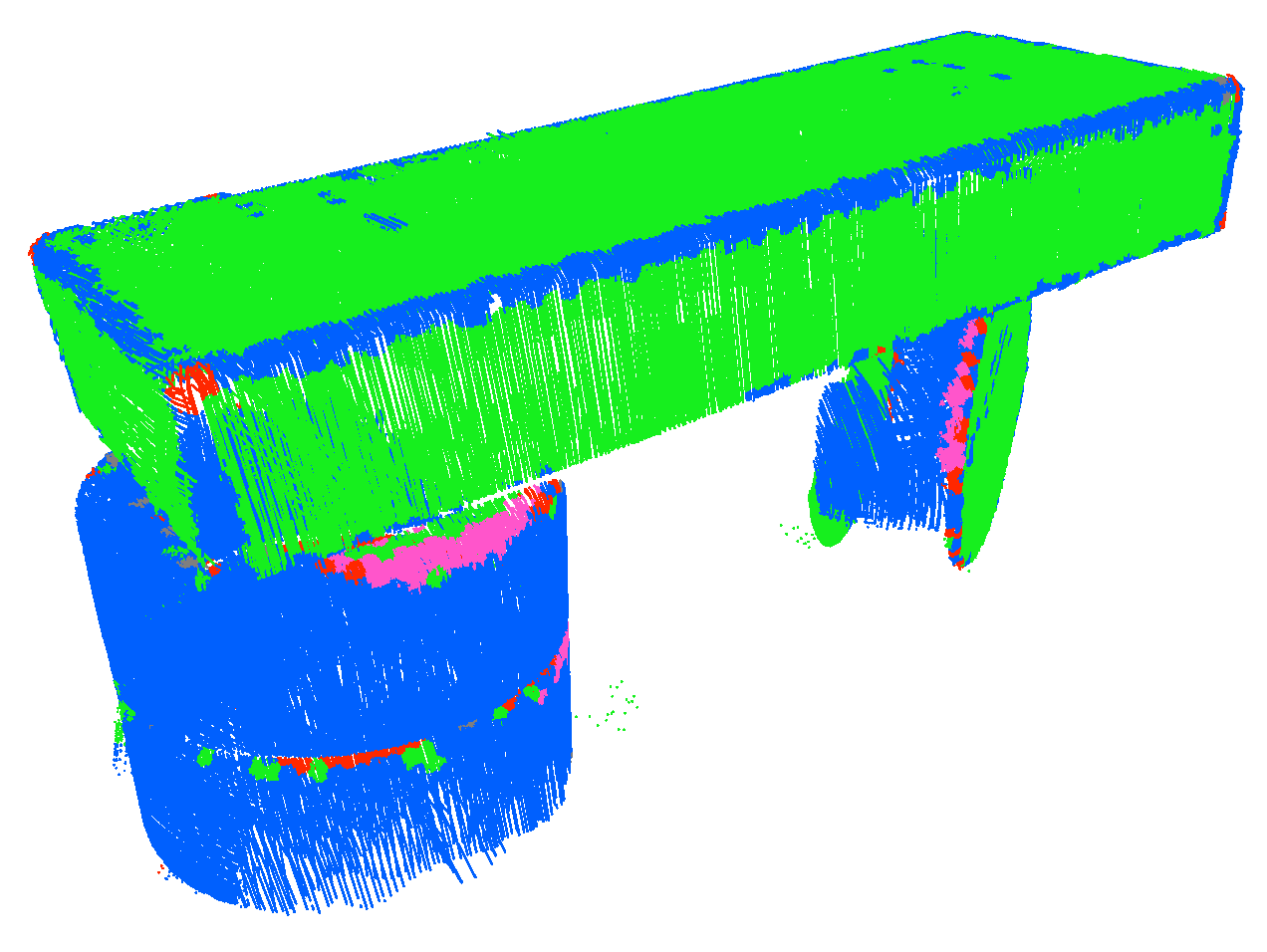 In reverse engineering and
computer-aided design (CAD) applications point cloud
data is usually manually scanned, reconstructed, and
post-processed in separated steps. When point cloud
data resulting from a scanning process do not satisfy
certain necessary reconstruction requirements, one
must perform scanning again to enable proper
reconstruction. On-line reconstruction of 3d geometry
allows one to generate and update a CAD reconstruction
online during the scanning process with an hand-held
laser scanner. Thus, regions where the scanned data is
insufficient for the reconstruction are detected on
the fly to allow an immediate correction and
improvement of the scanned data. This enables the
operator to focus on critical regions in the scanned
data to improve the reconstruction quality.
In reverse engineering and
computer-aided design (CAD) applications point cloud
data is usually manually scanned, reconstructed, and
post-processed in separated steps. When point cloud
data resulting from a scanning process do not satisfy
certain necessary reconstruction requirements, one
must perform scanning again to enable proper
reconstruction. On-line reconstruction of 3d geometry
allows one to generate and update a CAD reconstruction
online during the scanning process with an hand-held
laser scanner. Thus, regions where the scanned data is
insufficient for the reconstruction are detected on
the fly to allow an immediate correction and
improvement of the scanned data. This enables the
operator to focus on critical regions in the scanned
data to improve the reconstruction quality.We present an on-line segmentation and on-line reconstruction of basic geometric primitives. The presented methods allow for a real-time processing of a point stream. They utilize data structures that can be updated at any time when additional data from the stream has to be processed. This data is used to complete and improve the segmentation and reconstruction during the scanning process.
Available formats: pdf
Citation: BibTeX
3D hand gesture recognition based on sensor fusion of commodity hardware
Caputo, Denker, Dums, Umlauf
In: Reiterer, Deussen (eds.): Mensch & Computer 2012, pp. 293-302.
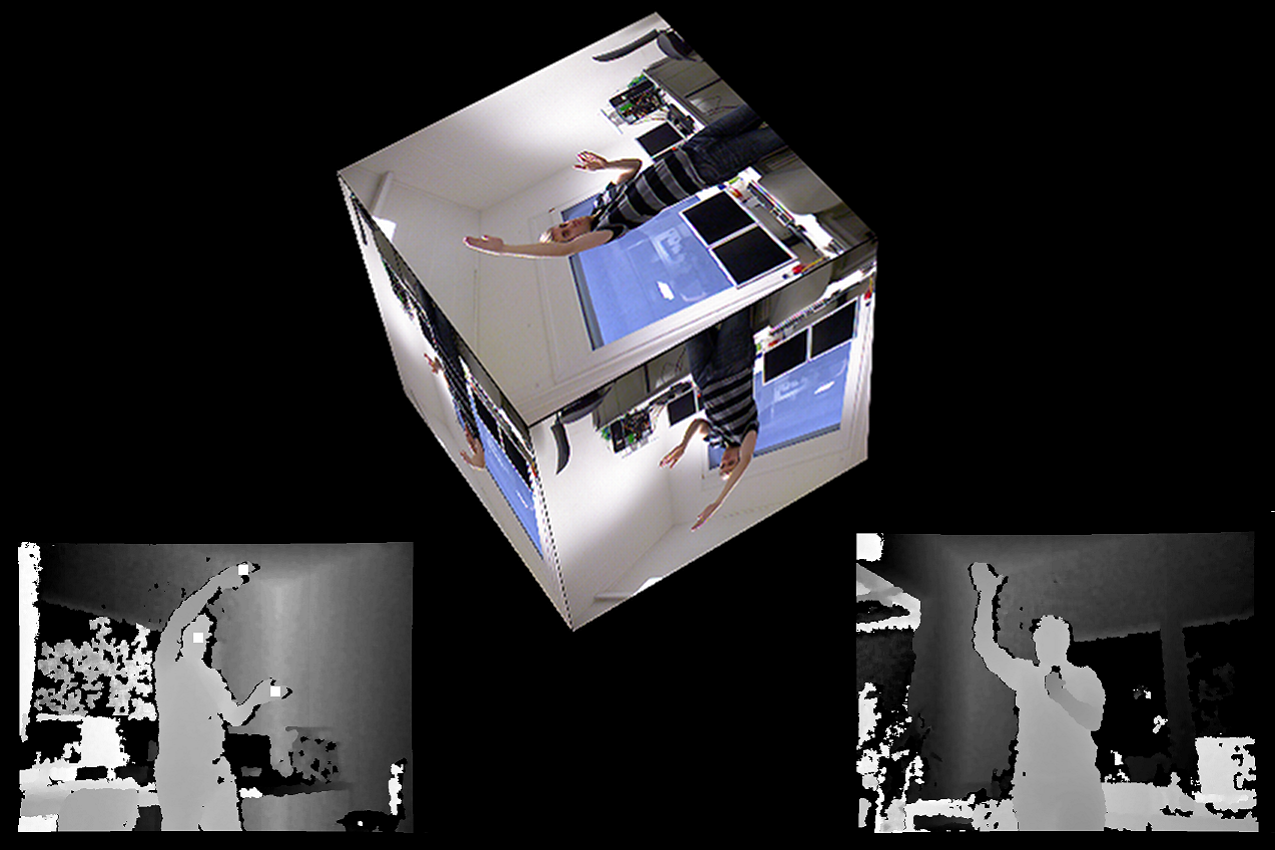
With the advent of
various video game consoles and tablet devices gesture
recognition got quite popular to control computer
systems. For example touch screens allow for an
intuitive control of small 2d user interfaces with
finger gestures. For interactive manipulation of 3d
objects in a large 3d projection environment a similar
intuitive 3d interaction method is required.
In this paper, we present a dynamic 3d hand and arm gesture recognition system using commodity hardware. The input data is captured with low cost depth sensors (e.g. Microsoft Kinect) and HD color sensors (e.g. Logitech C910). Our method combines dynamic hand and arm gesture recognition based on the depth sensor with static hand gesture recognition based on the HD color sensor.
In this paper, we present a dynamic 3d hand and arm gesture recognition system using commodity hardware. The input data is captured with low cost depth sensors (e.g. Microsoft Kinect) and HD color sensors (e.g. Logitech C910). Our method combines dynamic hand and arm gesture recognition based on the depth sensor with static hand gesture recognition based on the HD color sensor.
Available formats: pdf
Citation: BibTeX
A hand-held laser scanner based on multi-camera stereo-matching
Bender, Denker, Friedrich, Hirt, Umlauf
In: Garth et al (eds.), OASICS, 17: 123-133, 2012.
Mos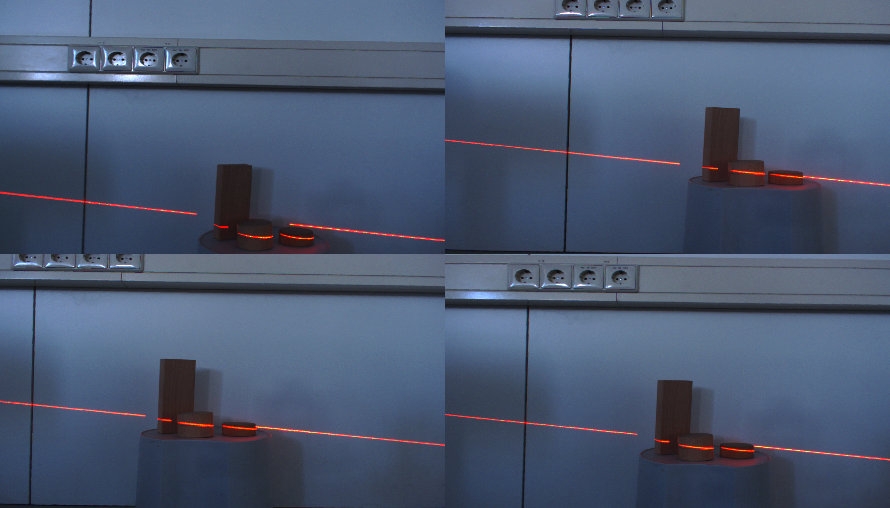 t
laser scanners in engineering are extended versions of
tactile measuring machines. These high
precision devices are typically very expensive and
hardware modifications are not possible without
impairing the precision of the device.
t
laser scanners in engineering are extended versions of
tactile measuring machines. These high
precision devices are typically very expensive and
hardware modifications are not possible without
impairing the precision of the device.
For these reasons we built our own laser-scanner system. It is based on a multi-camera reconstruction system developed for fast 3d face reconstructions. Based on this camera system we developed a laser-scanner using GPU accelerated stereo-matching techniques and a hand-held line-laser probe. The resulting reconstruction is solely based on the known camera positions and parameters. Thus, it is not necessary to track the position and movement of the line-laser probe. This yields an inexpensive laser-scanner system where every hardware component can be modified individually for experiments and future extensions of the system.
 t
laser scanners in engineering are extended versions of
tactile measuring machines. These high
precision devices are typically very expensive and
hardware modifications are not possible without
impairing the precision of the device.
t
laser scanners in engineering are extended versions of
tactile measuring machines. These high
precision devices are typically very expensive and
hardware modifications are not possible without
impairing the precision of the device. For these reasons we built our own laser-scanner system. It is based on a multi-camera reconstruction system developed for fast 3d face reconstructions. Based on this camera system we developed a laser-scanner using GPU accelerated stereo-matching techniques and a hand-held line-laser probe. The resulting reconstruction is solely based on the known camera positions and parameters. Thus, it is not necessary to track the position and movement of the line-laser probe. This yields an inexpensive laser-scanner system where every hardware component can be modified individually for experiments and future extensions of the system.
Available formats: pdf
Citation: BibTeX
Hybrid face recognition based on real-time multi-camera stereo-matching
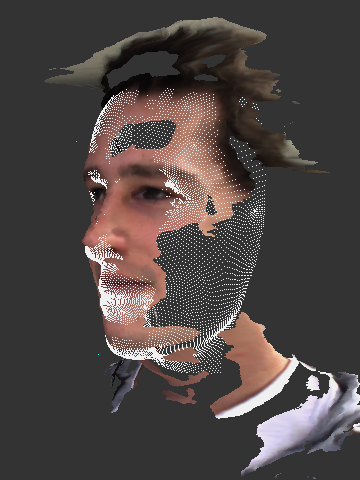
Hensler, Denker, Franz, Umlauf
In: G. Bebis et al. (eds.): ISVC 2011, Part II, LNCS 6930, 158-167, 2011.
Multi-camera
systems
and
GPU-based stereo-matching methods allow for a real-time
3d reconstruction of faces. We use the data generated by
such a 3d reconstruction for a hybrid face recognition
system based on color, accuracy, and depth information.
This system is structured in two subsequent phases:
geometry-based data preparation and face recognition
using wavelets and the AdaBoost algorithm. It requires
only one reference image per person. On a data base of
500 recordings, our system achieved detection rates
ranging from 95% to 97% with a false detection rate of
2% to 3%. The computation of the whole process takes
around 1.1 seconds.
Available formats: pdf
Citation: BibTeX
Finite element analysis for linear elastic solids based on subdivision schemes.
Burkhart, Hamann, Umlauf
In: Middel et al. (eds.), Visualization of Large and Unstructured Data Sets, OASICS, 19: 1-10, 2011.
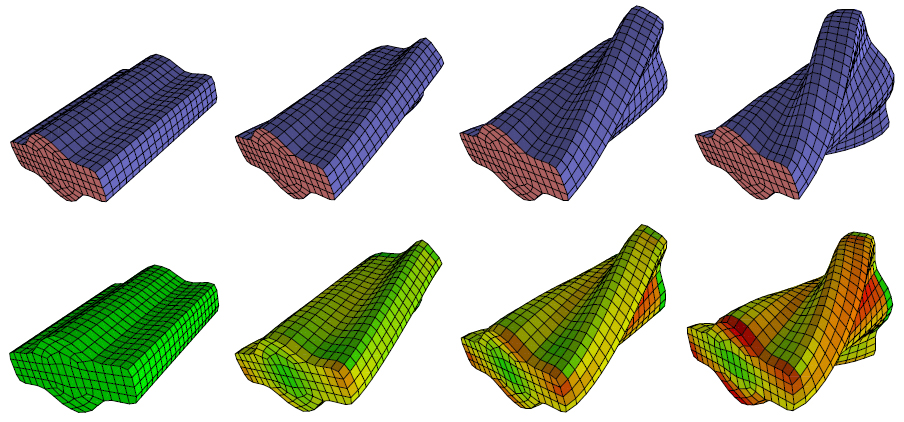
Finite element methods
are used in various areas ranging from mechanical
engineering to computer graphics and bio-medical
applications. In engineering, a critical point is
the gap between CAD and CAE. This gap results from
different representations used for geometric design
and physical simulation.
We present two different approaches for using subdivision solids as the only representation for modeling, simulation and visualization. This has the advantage that no data must be converted between the CAD and CAE phases. The first approach is based on an adaptive and feature-preserving tetrahedral subdivision scheme. The second approach is based on Catmull-Clark subdivision solids.
We present two different approaches for using subdivision solids as the only representation for modeling, simulation and visualization. This has the advantage that no data must be converted between the CAD and CAE phases. The first approach is based on an adaptive and feature-preserving tetrahedral subdivision scheme. The second approach is based on Catmull-Clark subdivision solids.
Available formats: pdf
Citation: BibTeX
An accurate real-time multi-camera matching on the GPU for 3d reconstruction.
Denker, Umlauf
Journal of WSCG, 19: 9-16, 2011.
Using multi-ca
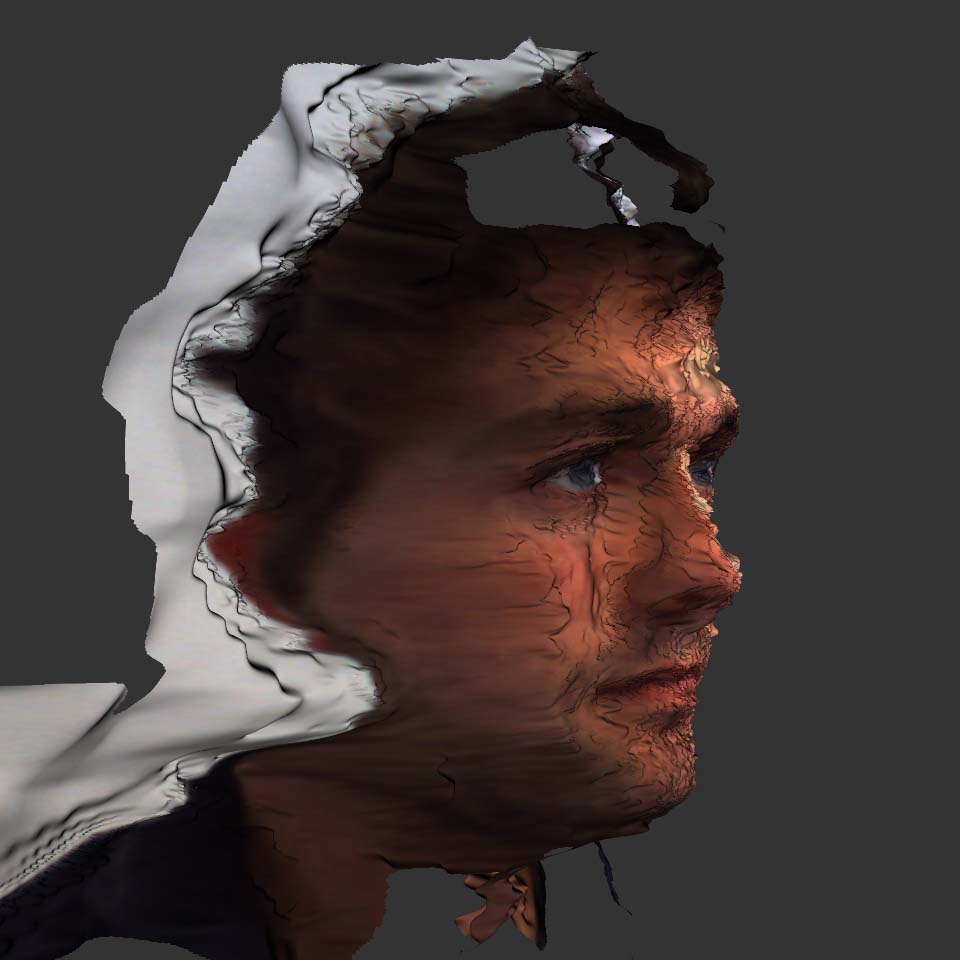 mera
matching techniques for 3d reconstruction there is
usually the trade-off between the quality
of
the
computed
depth
map
and
the
speed
of
the
computations.
Whereas
high
quality matching methods take several seconds to several
minutes to compute a depth map for one set of
images, real-time methods achieve only low quality
results. In this paper we present a multi-camera
matching method that runs in real-time
and yields high resolution depth maps.
mera
matching techniques for 3d reconstruction there is
usually the trade-off between the quality
of
the
computed
depth
map
and
the
speed
of
the
computations.
Whereas
high
quality matching methods take several seconds to several
minutes to compute a depth map for one set of
images, real-time methods achieve only low quality
results. In this paper we present a multi-camera
matching method that runs in real-time
and yields high resolution depth maps.Our method is based on a novel multi-level combination of normalized cross correlation, deformed matching windows based on the multi-level depth map information, and sub-pixel precise disparity maps. The whole process is implemented completely on the GPU. With this approach we can process four 0.7 megapixel images in 129 milliseconds to a full resolution 3d depth map. Because our technique is tailored for the recognition of non-technical shapes, our target application is face recognition.
Available formats: pdf
Citation: BibTeX
Survey on benchmarks for a GPU based multi camera stereo matching algorithm.
Denker, Umlauf
In: Middel et al. (eds.), Visualization of Large and Unstructured Data Sets, OASICS, 19: 20-26, 2011.
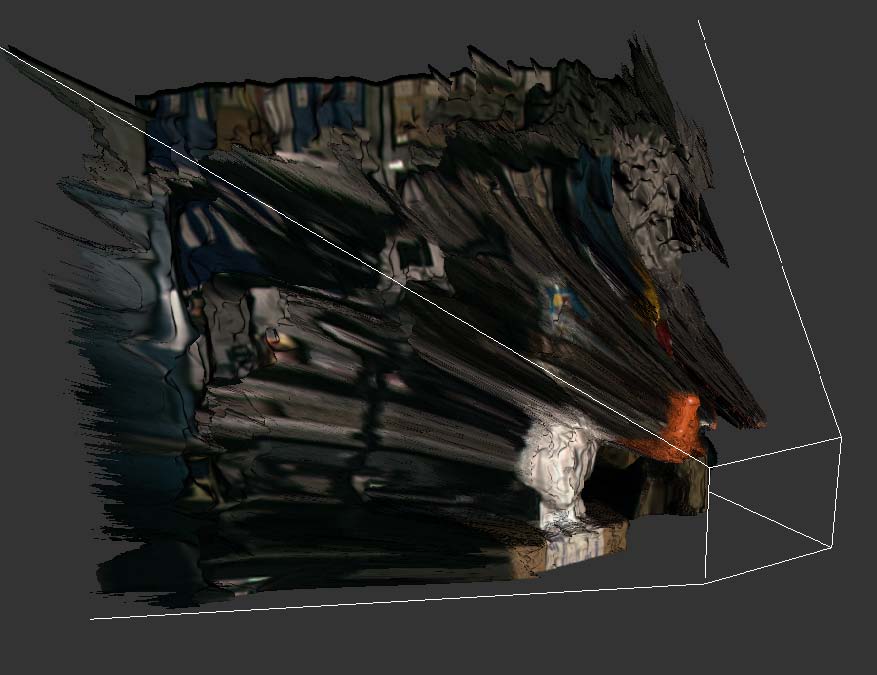
Stereo matching
algorithms and multi camera reconstruction algorithms
are usually compared using benchmarks. These
benchmarks compare the quality of the resulting depth
map or reconstructed surface mesh. We describe the
differences between several known stereo and
multi-view stereo benchmarks and their various
datasets. Also the modifications that are necessary to
use our own GPU based multi camera stereo matching
algorithm with the data from these benchmarks are
discussed.
Available formats: pdf
Citation: BibTeX
Real-time triangulation of point streams.
Denker, Lehner, Umlauf
Engineering with Computers, 27:67-80, 2011.
Hand-held laser scanners are
commonly used in industry for reverse
engineering and quality measurements. In this process, it is
difficult for the human operator to scan the target object
completely and uniformly. Therefore, an interactive triangulation
of the scanned points can
assist the operator in this task.
I n this paper we describe
the technical and implementational details of our real-time
triangulation approach for point streams, presented
at the 17th International Meshing Roundtable. Our method
computes a triangulation of the point stream generated by
the laser scanner online, i.e., the data points are added to
the triangulation as they are received from the scanner.
Multiple scanned areas and areas with a higher point density
result in a finer mesh and a higher accuracy. On the other hand, the
vertex density adapts to the estimated surface
curvature. To guide the operator the resulting triangulation is rendered
with a visualization of its uncertainty and the
display of an optimal scanning direction.
n this paper we describe
the technical and implementational details of our real-time
triangulation approach for point streams, presented
at the 17th International Meshing Roundtable. Our method
computes a triangulation of the point stream generated by
the laser scanner online, i.e., the data points are added to
the triangulation as they are received from the scanner.
Multiple scanned areas and areas with a higher point density
result in a finer mesh and a higher accuracy. On the other hand, the
vertex density adapts to the estimated surface
curvature. To guide the operator the resulting triangulation is rendered
with a visualization of its uncertainty and the
display of an optimal scanning direction.
Available formats: pdfI
 n this paper we describe
the technical and implementational details of our real-time
triangulation approach for point streams, presented
at the 17th International Meshing Roundtable. Our method
computes a triangulation of the point stream generated by
the laser scanner online, i.e., the data points are added to
the triangulation as they are received from the scanner.
Multiple scanned areas and areas with a higher point density
result in a finer mesh and a higher accuracy. On the other hand, the
vertex density adapts to the estimated surface
curvature. To guide the operator the resulting triangulation is rendered
with a visualization of its uncertainty and the
display of an optimal scanning direction.
n this paper we describe
the technical and implementational details of our real-time
triangulation approach for point streams, presented
at the 17th International Meshing Roundtable. Our method
computes a triangulation of the point stream generated by
the laser scanner online, i.e., the data points are added to
the triangulation as they are received from the scanner.
Multiple scanned areas and areas with a higher point density
result in a finer mesh and a higher accuracy. On the other hand, the
vertex density adapts to the estimated surface
curvature. To guide the operator the resulting triangulation is rendered
with a visualization of its uncertainty and the
display of an optimal scanning direction.Citation: BibTeX
Iso-geometric analysis based on Catmull-Clark subdivision solids.
Burkhart, Hamann, Umlauf
Computer Graphics Forum, 29(5): 1575-1584, 2010.
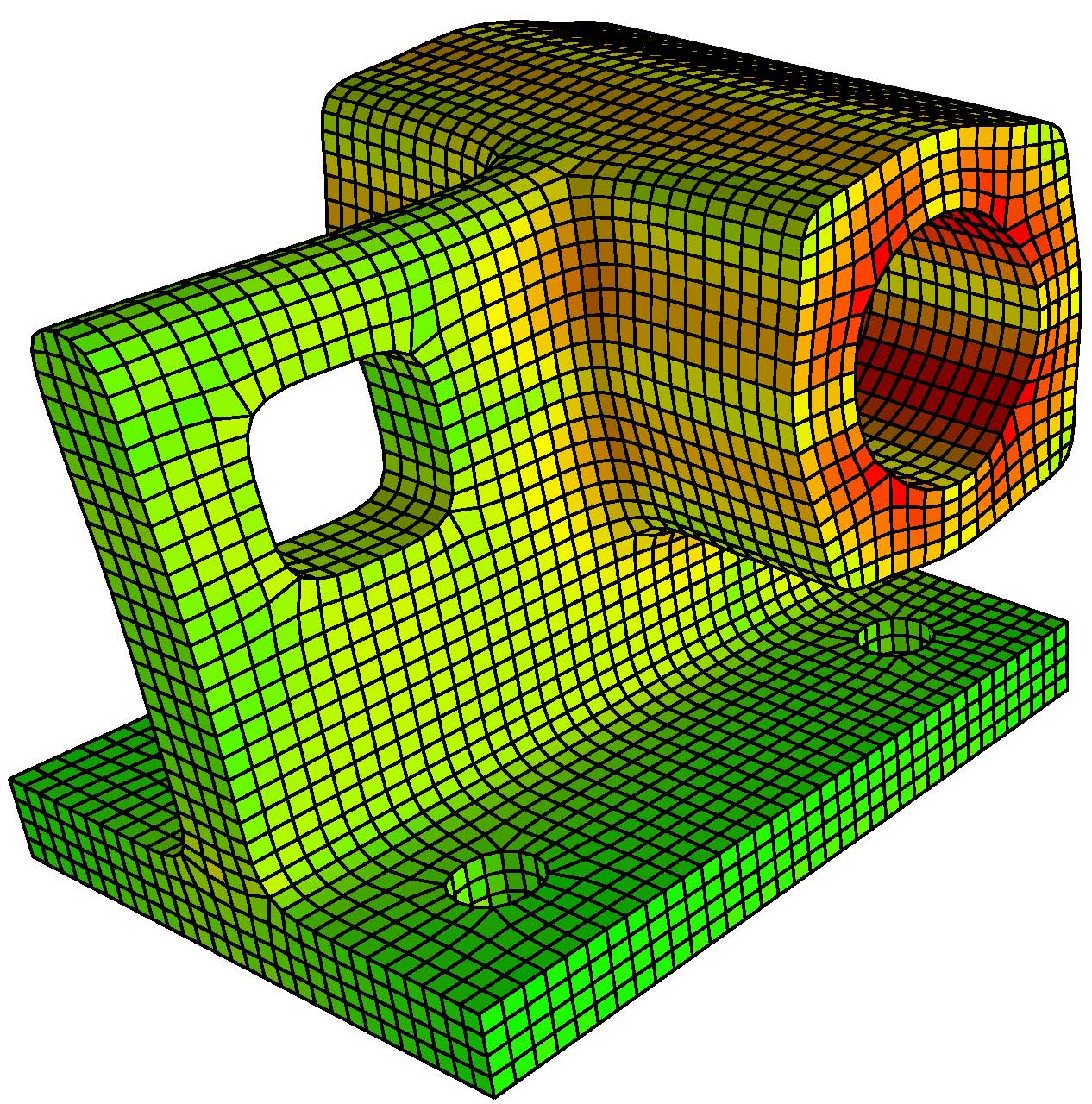
We
present a volumetric iso-geometric finite element
analysis based on Catmull-Clark solids. This
concept allows one to use the same representation for
the modeling, the physical simulation,
and the visualization, which
optimizes the design process and narrows the gap
between CAD and CAE. In our method the
boundary of the solid model is a Catmull-Clark surface
with optional corners and creases to
support the modeling phase. The
crucial point in the simulation phase is the need to
perform efficient integration for the elements. We
propose a method similar to the standard subdivision
surface evaluation technique, such
that numerical quadrature can be used.
Experiments show that our approach converges faster than methods based on tri-linear and tri-quadratic elements. However, the topological structure of Catmull-Clark elements is as simple as the structure of linear elements. Furthermore, the Catmull-Clark elements we use are C2-continuous on the boundary and in the interior except for irregular vertices and edges.
Experiments show that our approach converges faster than methods based on tri-linear and tri-quadratic elements. However, the topological structure of Catmull-Clark elements is as simple as the structure of linear elements. Furthermore, the Catmull-Clark elements we use are C2-continuous on the boundary and in the interior except for irregular vertices and edges.
Available formats: pdf
Citation: BibTeX
Adaptive tetrahedral subdivision for finite element analysis.
Burkhart, Hamann, Umlauf
Computer Graphics International, 2010.
Rea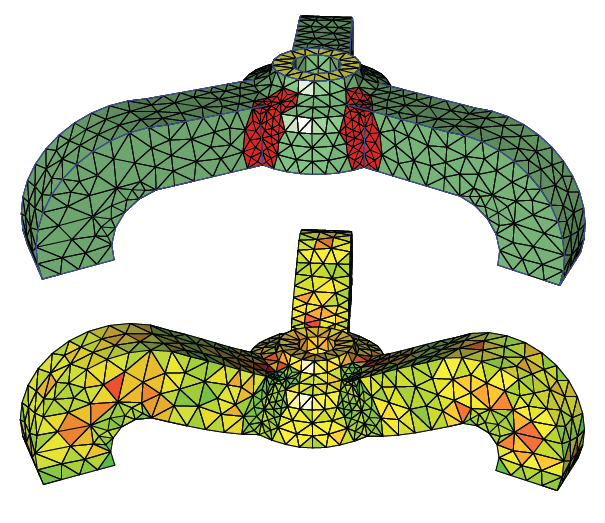 listic behavior of
deformable objects is essential for many
applications in computer graphics, engineering, or
medicine. Typical techniques are either based on
mass-spring-damper models, boundary element methods, finite
difference methods, or finite element methods. These methods
either lack accuracy or are computationally
very expensive. If accuracy is required FEM
computations use adaptive refinement, where regions with high
gradients are refined locally. The bottleneck of this
approach is still the gap between CAD and CAE
representations.
listic behavior of
deformable objects is essential for many
applications in computer graphics, engineering, or
medicine. Typical techniques are either based on
mass-spring-damper models, boundary element methods, finite
difference methods, or finite element methods. These methods
either lack accuracy or are computationally
very expensive. If accuracy is required FEM
computations use adaptive refinement, where regions with high
gradients are refined locally. The bottleneck of this
approach is still the gap between CAD and CAE
representations.
We present an approach to utilize solid subdivision for finite element simulations using an adaptive tetrahedral subdivision scheme based on sqrt(3)-subdivision for triangular meshes. The advantage of this approach is the use of the subdivision representation the modeling, the visualization and the simulation of the solid model.
 listic behavior of
deformable objects is essential for many
applications in computer graphics, engineering, or
medicine. Typical techniques are either based on
mass-spring-damper models, boundary element methods, finite
difference methods, or finite element methods. These methods
either lack accuracy or are computationally
very expensive. If accuracy is required FEM
computations use adaptive refinement, where regions with high
gradients are refined locally. The bottleneck of this
approach is still the gap between CAD and CAE
representations.
listic behavior of
deformable objects is essential for many
applications in computer graphics, engineering, or
medicine. Typical techniques are either based on
mass-spring-damper models, boundary element methods, finite
difference methods, or finite element methods. These methods
either lack accuracy or are computationally
very expensive. If accuracy is required FEM
computations use adaptive refinement, where regions with high
gradients are refined locally. The bottleneck of this
approach is still the gap between CAD and CAE
representations.We present an approach to utilize solid subdivision for finite element simulations using an adaptive tetrahedral subdivision scheme based on sqrt(3)-subdivision for triangular meshes. The advantage of this approach is the use of the subdivision representation the modeling, the visualization and the simulation of the solid model.
Available formats: pdf
Citation: BibTeX
Adaptive and feature-preserving subdivision for high-quality tetrahedral meshes.
Burkhart, Hamann, Umlauf
Computer Graphics Forum, 29(1): 117-127, 2010.
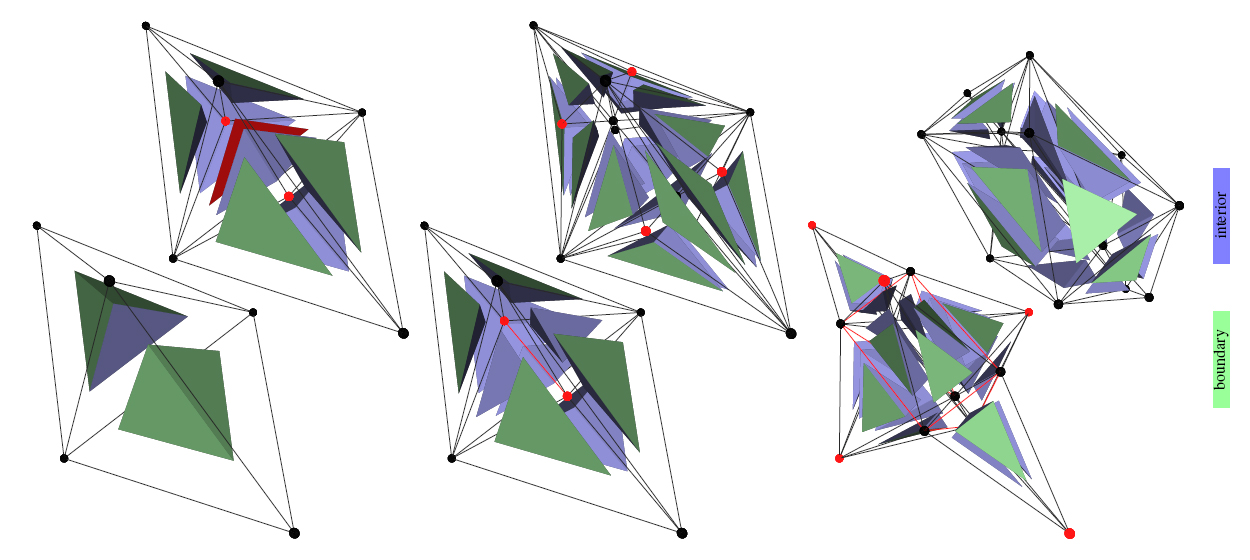
We present
an adaptive subdivision scheme for unstructured
tetrahedral
meshes inspired by the sqrt(3)-subdivision scheme for
triangular meshes. Existing tetrahedral
subdivision schemes do not support adaptive refinement
and have traditionally been driven by the need to
generate smooth three-dimensional deformations of
solids. These schemes use edge bisections to subdivide
tetrahedra, which generates octahedra in addition to
tetrahedra. To split octahedra into tetrahedra one
routinely chooses a direction for the diagonals for the
subdivision step. We propose a new topology-based
refinement operator that generates only
tetrahedra and supports adaptive refinement. Our
tetrahedral subdivision algorithm is motivated by the
need to have one representation for the modeling,
the simulation and the visualization and so to
bridge the gap between CAD and CAE. Our subdivision
algorithm design emphasizes on geometric quality of the
tetrahedral meshes, local and adaptive refinement
operations, and preservation of sharp geometric features
on the boundary and in the interior of the physical
domain.
Available formats: pdf
Citation: BibTeX
Geometric properties of the adaptive Delaunay triangulation.
Bobach, Constantiniu, Steinmann, Umlauf
In: M. Dæhlen et al. (eds.), Mathematical Methods for Curves and Surfaces, Springer-Verlag, 41-54, 2010.
Recently, the Adaptive
Delaunay Tessellation (ADT) was introduced in the
context of computational mechanics as a tool to support
Voronoi-based nodal integration schemes in the finite
element method. While focusing on applications in
mechanical engineering, the former presentation lacked
rigorous proofs for the claimed geometric properties of
the ADT necessary for the computation of the nodal
integration scheme. This paper gives the missing proofs
for the three main claims which are uniqueness of the
ADT, connectedness of the ADT, and coverage of the
Voronoi tiles by adjacent ADT tiles. Furthermore, this
paper provides a critical assessment of the ADT for
arbitrary point sets.
Available formats: pdf
Citation: BibTeX
Available formats: pdf
Citation: BibTeX
Generalized swap operations for tetrahedrizations.
Lehner, Hamann, Umlauf
In: H.Hagen (eds): Scientific Visualization - Advanced Concepts, 30-44, 2010.
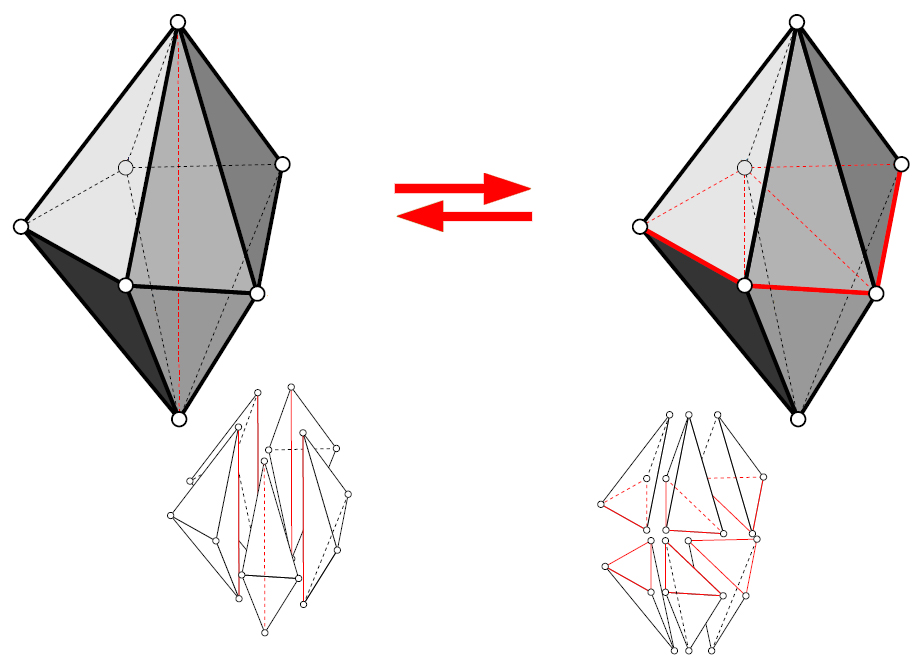 Mesh
optimization of 2D and 3D triangulations is used in
multiple applications extensively. For example, mesh
optimization is crucial in the context of adaptively
discretizing geometry, typically representing the
geometrical boundary conditions of a numerical
simulation, or adaptively discretizing
the entire space over which various dependent variables
of a numerical simulation must be approximated. Together
with operations applied to the vertices the so-called
edge or face swap operations are the
building block of all optimization approaches. To speed
up the optimization or to avoid local minima of the
function measuring overall mesh quality these swaps are
combined to generalized swap operations with a less
local impact on the triangulation. Despite the fact that
these swap operations change only the connectivity of a
triangulation, it depends on the geometry of the
triangulation whether the generalized swap will generate
inconsistently oriented or degenerate simplices. Because
these are undesirable for numerical reasons, this paper
is concerned with geometric criteria that guarantee the
generalized swaps for a 3D triangulation to yield only
valid, non-degenerate triangulations.
Mesh
optimization of 2D and 3D triangulations is used in
multiple applications extensively. For example, mesh
optimization is crucial in the context of adaptively
discretizing geometry, typically representing the
geometrical boundary conditions of a numerical
simulation, or adaptively discretizing
the entire space over which various dependent variables
of a numerical simulation must be approximated. Together
with operations applied to the vertices the so-called
edge or face swap operations are the
building block of all optimization approaches. To speed
up the optimization or to avoid local minima of the
function measuring overall mesh quality these swaps are
combined to generalized swap operations with a less
local impact on the triangulation. Despite the fact that
these swap operations change only the connectivity of a
triangulation, it depends on the geometry of the
triangulation whether the generalized swap will generate
inconsistently oriented or degenerate simplices. Because
these are undesirable for numerical reasons, this paper
is concerned with geometric criteria that guarantee the
generalized swaps for a 3D triangulation to yield only
valid, non-degenerate triangulations.Natural neighbor extrapolation using ghost points.
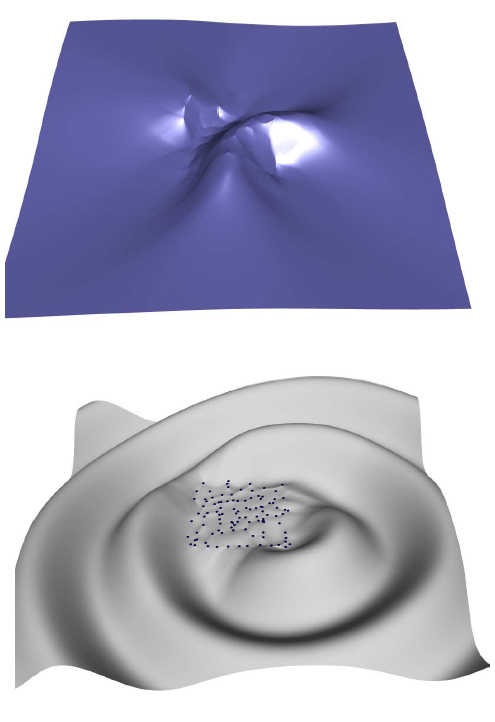
Bobach, Farin, Hansford, Umlauf
Computer Aided-Design, 41(5): 350-365, 2009.
Among locally supported
scattered data schemes, natural neighbor interpolation
has some unique features that makes it interesting for a
range of applications. However, its restriction to the
convex hull of the data sites is a limitation that has
not yet been satisfyingly overcome. We use this setting
to discuss some aspects of scattered data extrapolation
in general, compare existing methods, and propose a
framework for the extrapolation of natural
neighbor interpolants on the basis of dynamic ghost
points.
Available formats: pdf
Citation: BibTeX
Online triangulation of laser-scan data.
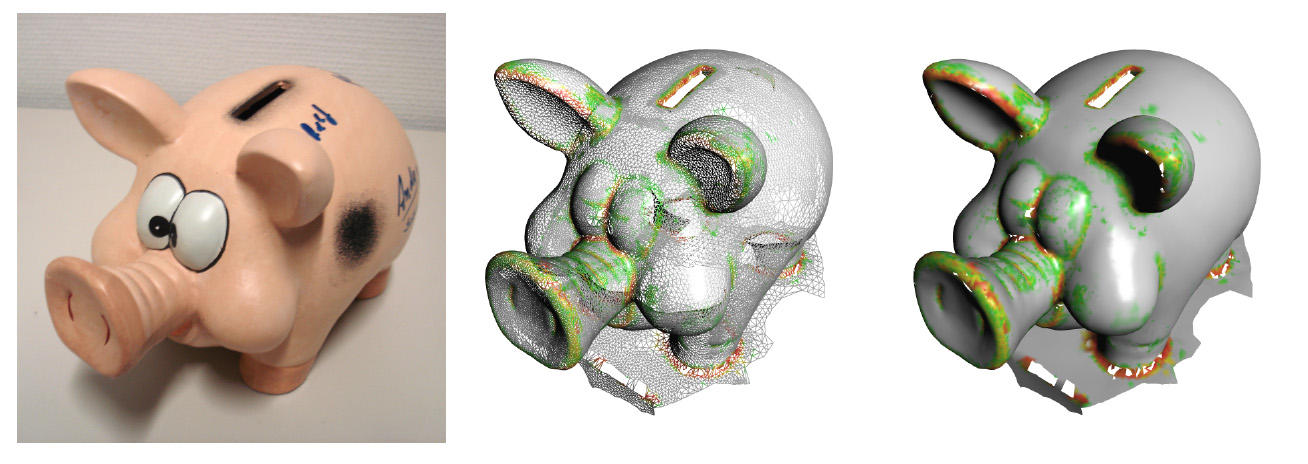
Denker, Lehner, Umlauf
In: R. Garimella (ed.), Proceedings of the 17th International Meshing Roundtable, Springer-Verlag, 415-432, 2008.
Hand-held laser scanners
are used massively in industry for reverse engineering
and quality measurements. In this process, it is
difficult for the human operator to cover the scanned
object completely and uniformly. Therefore, an
interactive triangulation of the scanned surface
points can assist the human operator in this task.
Our method computes a triangulation of the point stream generated by the laser scanner online, i.e., the data points are added to the triangulation as they are received from the scanner. Multiple scanned areas and areas with a higher point density result in a finer mesh and a higher accuracy. On the other hand, the vertex density adapts to the estimated surface curvature. To assist the human operator the resulting triangulation is rendered with a visualization of its faithfulness. Additionally, our triangulation method allows for a level-of-detail representation to reduce the mesh complexity for fast rendering on low-cost graphics hardware.
Our method computes a triangulation of the point stream generated by the laser scanner online, i.e., the data points are added to the triangulation as they are received from the scanner. Multiple scanned areas and areas with a higher point density result in a finer mesh and a higher accuracy. On the other hand, the vertex density adapts to the estimated surface curvature. To assist the human operator the resulting triangulation is rendered with a visualization of its faithfulness. Additionally, our triangulation method allows for a level-of-detail representation to reduce the mesh complexity for fast rendering on low-cost graphics hardware.
Available formats: pdf
Citation: BibTeX
Videos: avi
Video compression using data-dependent triangulations.
Lehner, Umlauf, Hamann
In: Y. Xiao, E. ten Thij (eds.), Computer Graphics and Visualization '08, 244-248, 2008.
Best short-paper award.
We present a method for
compression of video clips using data-dependent
triangulations. This technique utilizes the time
coherence of a video to transfer information from one
frame to the next, reducing the computation time for the
compression. The results of this method are compared to
those obtained with MJPEG and MPEG-2.

Available formats: pdf
Citation: BibTeX
Videos: avi
The adaptive Delaunay tessellation: A neighborhood covering meshing technique.
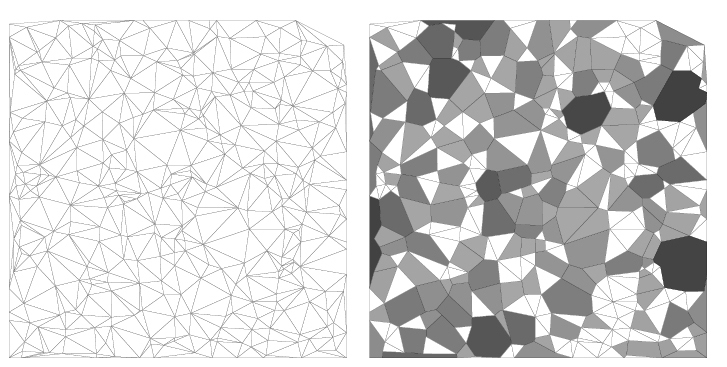
Constantiniu, Steinmann, Bobach, Farin, Umlauf
Computational Mechanics, 42(5), 655-669, 2008.
In
this paper we propose an
unstructured hybrid tessellation of a scattered point
set that minimally covers the proximal space around
each point. The mesh is automatically obtained in a
bounded period of time by transforming an initial
Delaunay tessellation. Novel types of polygonal
interpolants are used for interpolation applications
and geometric quantities of the elements make them
also useful for discretization schemes. The approach
proves to be superior to classical Delaunay one in a
finite element
context.
Available formats: pdf
Citation: BibTeX
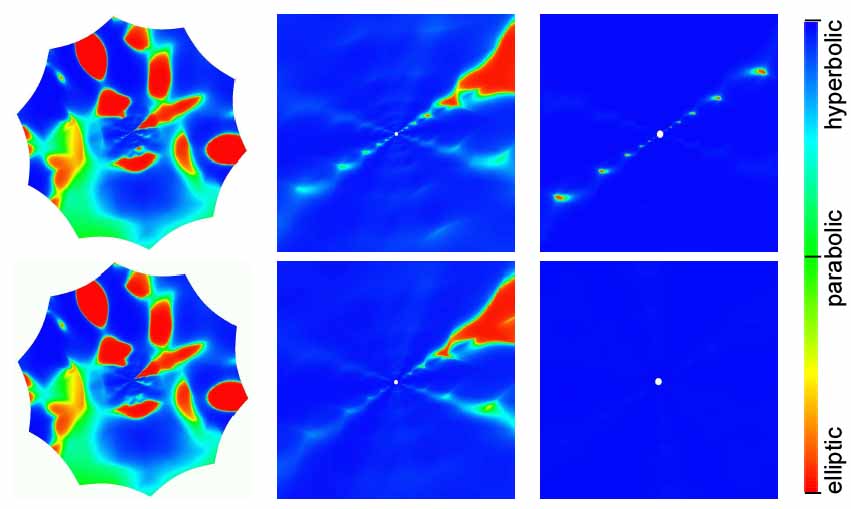 Local energy-optimizing subdivision
algorithms.
Local energy-optimizing subdivision
algorithms.Ginkel, Umlauf
Computer Aided Geometric Design, 25(3): 137-147, 2008.
In
this paper a method is presented to fair the limit
surface of a subdivision algorithm locally around an
extraordinary point. The dominant six eigenvalues of
the subdivision matrix have to satisfy linear and
quadratic equality- and inequality-constraints in
order to guarantee normal-continuity and bounded
curvature at the extraordinary point. All other
eigenvalues can be chosen arbitrarily within certain
intervals and therefore can be used to optimize the
shape of the subdivision surface by minimizing
quadratic energy functionals. Additionally, if the
sub- and subsub-dominant eigenvalues vary within
predefined intervals, C1-regularity
of
the
surface
and
locality
of
the
stencils
can
be
guaranteed,
although
eigenvectors
are
changed.
Available formats: pdf
Citation: BibTeX
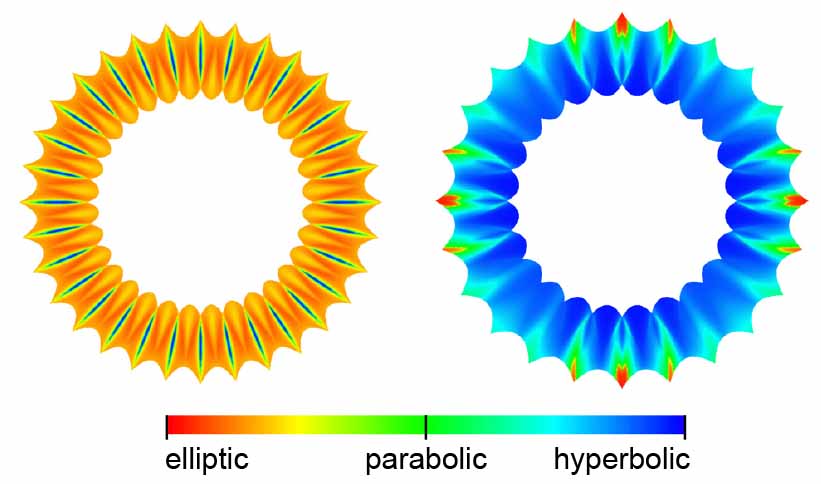 Symmetry
of shape
charts.
Symmetry
of shape
charts.Ginkel, Umlauf
Computer Aided Geometric Design, 24(3): 131-136, 2008.
For
subdivision surfaces, the so-called shape chart can be
used to characterize the curvature behavior at an
extraordinary point a priori from the initial control
net. Of late, it has been used in different approaches
to tune subdivision algorithms to handle the so-called
hybrid shapes. For this the shape charts are computed
numerically. In this paper, symmetries of shape charts
are analyzed that can be used to simplify the
computations and to reduce the computation costs
significantly.
Available formats: pdf
Citation: BibTeX
Discrete harmonic functions from local coordinates.
Bobach, Farin, Hansford, Umlauf
In: R. Martin, M. Sabin, J. Winkler (eds.), Mathematics of Surfaces XII, Springer-Verlag, 93-103, 2007.
 In this work we
focus on approximations of continuous harmonic functions
by discrete harmonic functions based on the discrete
Laplacian in a triangulation of a point set. We show how
the choice of edge weights based on generalized
barycentric coordinates influences the approximation
quality of discrete harmonic functions. Furthermore, we
consider a varying point set to demonstrate that
generalized barycentric coordinates based on natural
neighbors admit discrete harmonic functions that
continuously depend on the point set.
In this work we
focus on approximations of continuous harmonic functions
by discrete harmonic functions based on the discrete
Laplacian in a triangulation of a point set. We show how
the choice of edge weights based on generalized
barycentric coordinates influences the approximation
quality of discrete harmonic functions. Furthermore, we
consider a varying point set to demonstrate that
generalized barycentric coordinates based on natural
neighbors admit discrete harmonic functions that
continuously depend on the point set.Citation: BibTeX
Natural neighbor concepts in scattered data interpolation and discrete function approximation.
Bobach, Umlauf
In: H. Hagen, M. Hering-Bertram, C. Garth (eds.), GI Lecture Notes in Informatics, Visualization of Large and Unstructured Data Sets, 23-35, 2007.
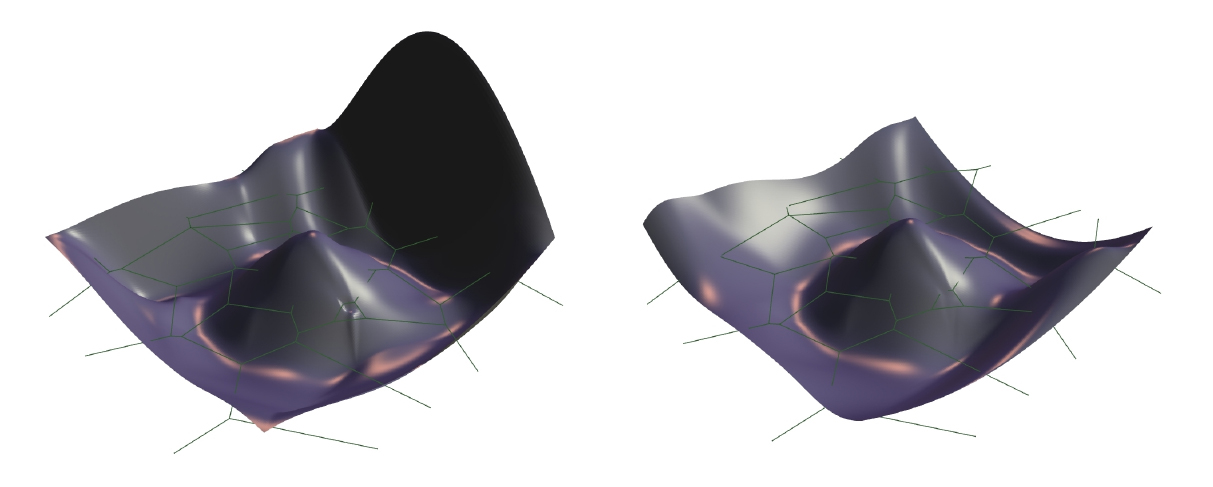
The concept of natural neighbors employs the
notion of distance to define local neighborhoods in
discrete data. Especially when querying and accessing
large scale data, it is important
to limit the amount of data that has to be processed for
an answer. Because of its implicit definition on
distances, the natural neighbor concept is extremely
well suited to provide meaningful neighborhoods in
spatial data with a scattered, inhomogeneous
distribution.
This paper revisits some unique properties of natural neighbor based methods and summarizes important findings for their successful application to scattered data interpolation, and the computation of discrete harmonic functions.
This paper revisits some unique properties of natural neighbor based methods and summarizes important findings for their successful application to scattered data interpolation, and the computation of discrete harmonic functions.
Citation: BibTeX
Analyzing a generalized Loop subdivision scheme.
Ginkel, Umlauf
Computing, 79(2-4), 353-363, 2007.
In this paper a
class subdivision schemes generalizing the algorithm of
Loop is presented. The stencils have same support as
those from the algorithm of Loop, but allow a variety of
weights. By varying the weights a class of C1
regular subdivision schemes is obtained. This class
includes the algorithm of Loop and the midpoint schemes
of order one and two for triangular nets. The proof of C1
regularity of the limit surface for arbitrary triangular
nets is provided for any choice of feasible weights.
The purpose of this generalization of the subdivision algorithm of Loop is to demonstrate the capabilities of the applied analysis technique. Since this class includes schemes that do not generalize box spline subdivision, the analysis of the characteristic map is done with a technique that does not need an explicit piecewise polynomial representation. This technique is computationally simple and can be used to analyze classes of subdivision schemes. It extends previously presented techniques based on geometric criteria.
The purpose of this generalization of the subdivision algorithm of Loop is to demonstrate the capabilities of the applied analysis technique. Since this class includes schemes that do not generalize box spline subdivision, the analysis of the characteristic map is done with a technique that does not need an explicit piecewise polynomial representation. This technique is computationally simple and can be used to analyze classes of subdivision schemes. It extends previously presented techniques based on geometric criteria.
Available formats: pdf
Citation: BibTeX
 Tuning subdivision
algorithms using constrained energy minimization.
Tuning subdivision
algorithms using constrained energy minimization.Ginkel, Umlauf
In: R. Martin, M. Sabin, J. Winkler (eds.), Mathematics of Surfaces XII, Springer-Verlag, 166-176, 2007.
In this paper a
method is presented to fair the limit surface of a
subdivision algorithm around an extraordinary point. The
eigenvalues and eigenvectors of the subdivision matrix
determine the continuity and shape of the limit surface.
The dominant, sub-dominant and subsub-dominant
eigenvalues should satisfy linear and quadratic
equality- and inequality-constraints to guarantee
continuous normal and bounded curvature globally. The
remaining eigenvalues need only satisfy linear
inequality-constraints. In general, except for the
dominant eigenvalue, all eigenvalues can be used to
optimize the shape of the limit surface with our method.
Available formats: pdf
Citation: BibTeX
Normals of subdivision surfaces and their control polyhedra.
Ginkel, Peters, Umlauf
Computer Aided Geometric Design, 24(2): 112-116, 2007.
For planar spline
curves and bivariate box-spline functions, the cone of
normals of a polynomial spline piece is enclosed by the
cone of normals of its spline control polyhedron. This
note collects some concrete examples to show that this
is not true for subdivision surfaces, both at
extraordinary points and in the regular, box-spline
setting. A larger set, the cross products of families of
control net edges, has to be considered.
Available formats: pdf
Citation: BibTeX
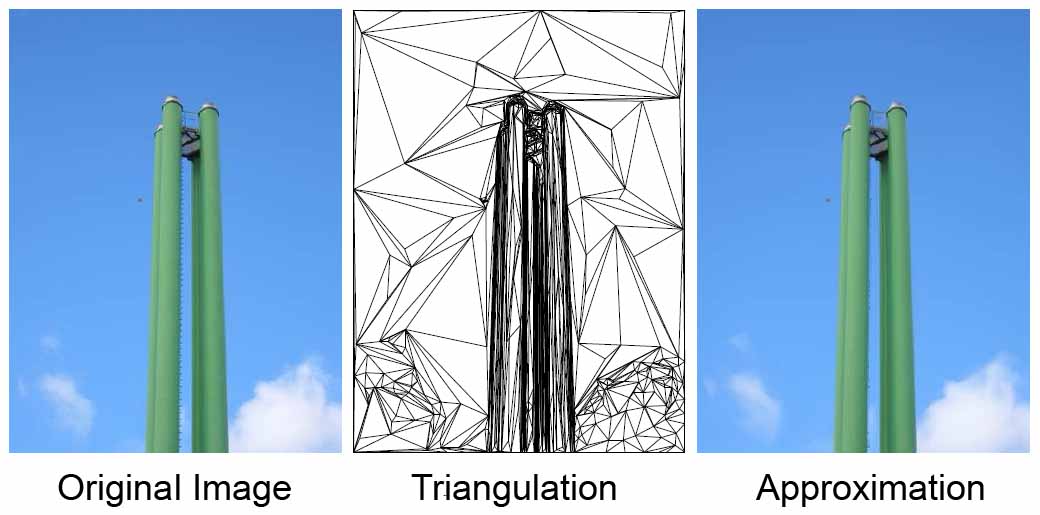 Image
compression using data-dependent triangulations.
Image
compression using data-dependent triangulations.Lehner, Umlauf, Hamann
In: G. Bebis et al. (eds.), Advances in Visual Computing, Part I, Springer-Verlag, 352-362, 2007.
We present a method
to speed up the computation of a high-quality
data-dependent triangulation approximating an image
using simulated annealing by probability distributions
guided by local approximation error and its variance.
The triangulation encodes the image, yielding
compression rates comparable to or even superior to JPEG
and JPEG2000 compression.
The specific contributions of our paper are a speed-up of the simulated annealing optimization and a comparison of our approach to other image approximation and compression methods. Furthermore, we propose an adaptive vertex insertion/removal strategy and termination criteria for the simulated annealing to achieve specified approximation error bounds.
The specific contributions of our paper are a speed-up of the simulated annealing optimization and a comparison of our approach to other image approximation and compression methods. Furthermore, we propose an adaptive vertex insertion/removal strategy and termination criteria for the simulated annealing to achieve specified approximation error bounds.
Available formats: pdf
Citation: BibTeX
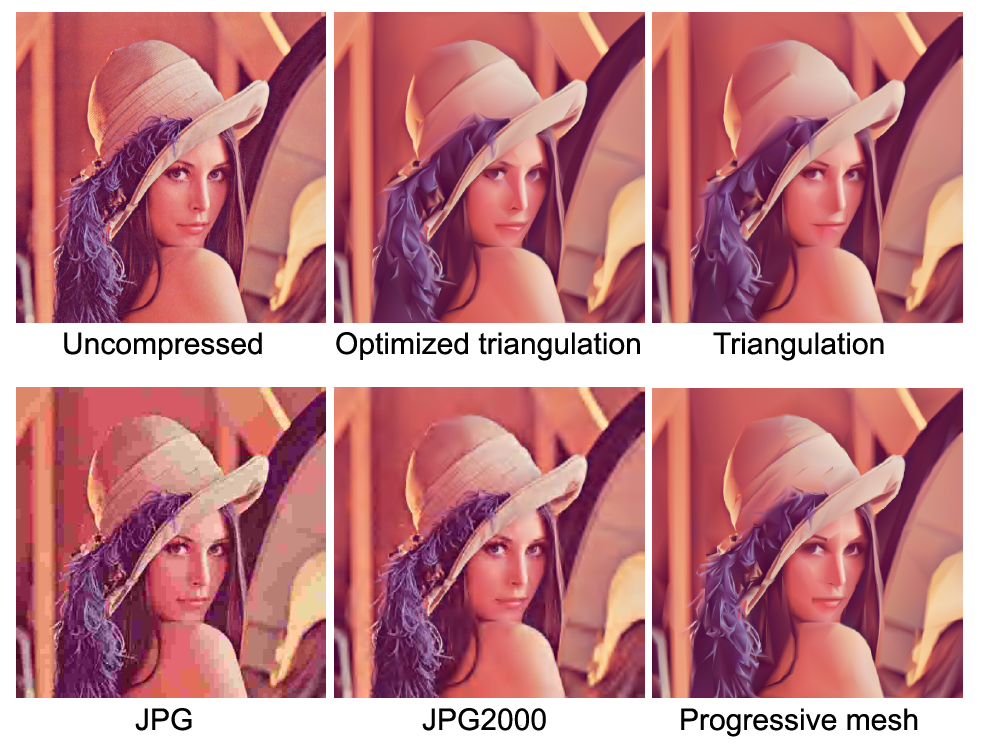 Survey of techniques for data-dependent
triangulations.
Survey of techniques for data-dependent
triangulations.Lehner, Umlauf, Hamann
In: H. Hagen, M. Hering-Bertram, C. Garth (eds.), GI Lecture Notes in Informatics, Visualization of Large and Unstructured Data Sets, 178-187, 2007.
We present a survey
of different techniques to approximate a color image
using a piecewise linear interpolation induced by a
triangulation of the image domain. We also include a
detailed description of a method we designed. We give a
short overview of possible applications and extensions.
Available formats: pdf
Citation: BibTeX
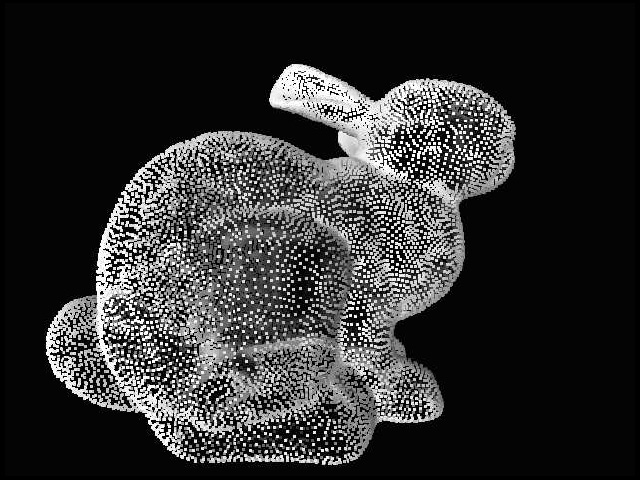 Embedded
vertex shader in FPGA.
Embedded
vertex shader in FPGA.Middendorf, Mühlbauer, Umlauf, Bobda
In: A. Rettberg et al. (eds.), Embedded System Design: Topics, Techniques and Trendes, Springer, 155-164, 2007.
Real-time 3D
visualization of objects or information becomes
increasingly important in everyday life e.g. in cellular
phones or mobile systems. Care should be taken in the
design and implementation 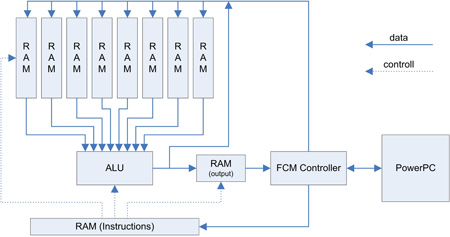 of 3D
rendering in such embedded devices like handheld devices
in order to meet the performance requirement, while
maintaining power consumption low. In this work, the
design and implementation of a vertex shader on a
reconfigurable hardware is presented. The main focus is
placed on the efficient hardware/software partitioning
of the vertex shader computation, in order to maximize
the performance while maintaining a high flexibility.
The resulting solution must be compatible to existing
vertex shaders in oder to allow the large amount of
existing program to be easily ported to our platform. A
prototype consisting of a PowerPC, peripherals and some
custom hardware modules is realized a on an FPGA-board.
The implementation of a point rendering shows
considerable speed up compared to a pure software
solution.
of 3D
rendering in such embedded devices like handheld devices
in order to meet the performance requirement, while
maintaining power consumption low. In this work, the
design and implementation of a vertex shader on a
reconfigurable hardware is presented. The main focus is
placed on the efficient hardware/software partitioning
of the vertex shader computation, in order to maximize
the performance while maintaining a high flexibility.
The resulting solution must be compatible to existing
vertex shaders in oder to allow the large amount of
existing program to be easily ported to our platform. A
prototype consisting of a PowerPC, peripherals and some
custom hardware modules is realized a on an FPGA-board.
The implementation of a point rendering shows
considerable speed up compared to a pure software
solution.
 of 3D
rendering in such embedded devices like handheld devices
in order to meet the performance requirement, while
maintaining power consumption low. In this work, the
design and implementation of a vertex shader on a
reconfigurable hardware is presented. The main focus is
placed on the efficient hardware/software partitioning
of the vertex shader computation, in order to maximize
the performance while maintaining a high flexibility.
The resulting solution must be compatible to existing
vertex shaders in oder to allow the large amount of
existing program to be easily ported to our platform. A
prototype consisting of a PowerPC, peripherals and some
custom hardware modules is realized a on an FPGA-board.
The implementation of a point rendering shows
considerable speed up compared to a pure software
solution.
of 3D
rendering in such embedded devices like handheld devices
in order to meet the performance requirement, while
maintaining power consumption low. In this work, the
design and implementation of a vertex shader on a
reconfigurable hardware is presented. The main focus is
placed on the efficient hardware/software partitioning
of the vertex shader computation, in order to maximize
the performance while maintaining a high flexibility.
The resulting solution must be compatible to existing
vertex shaders in oder to allow the large amount of
existing program to be easily ported to our platform. A
prototype consisting of a PowerPC, peripherals and some
custom hardware modules is realized a on an FPGA-board.
The implementation of a point rendering shows
considerable speed up compared to a pure software
solution.Available formats: pdf
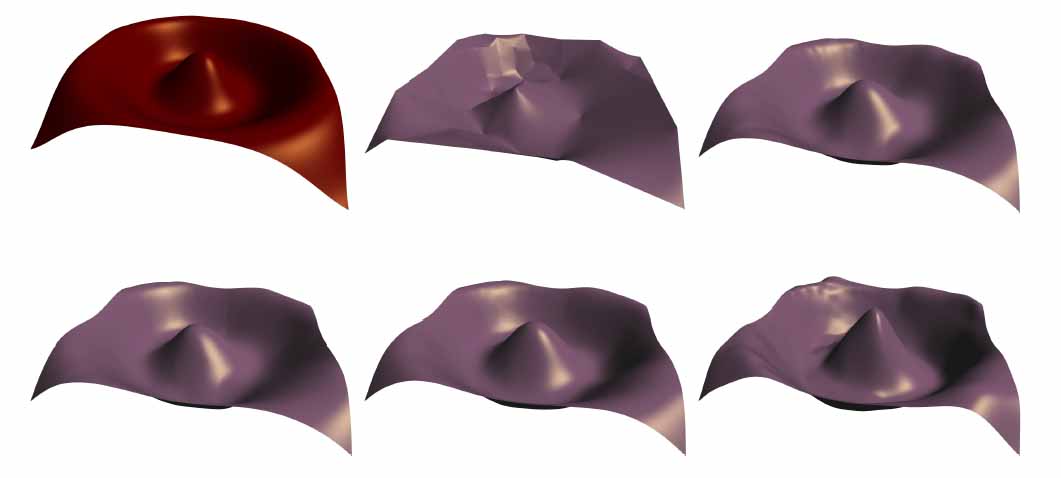 Comparison of Voronoi based scattered data
interpolation schemes.
Comparison of Voronoi based scattered data
interpolation schemes. Bobach, Bertram, Umlauf
In: J.J. Villanueva (ed.), Proceedings of International Conference on Visualization, Imaging and Image Processing, 342-349, 2006.
Voronoi based
interpolation employs the concept of natural neighbors
to define an interpolating function over discrete data
known at scattered sample points. In this work we review
the two main concepts for improving interpolation
continuity inside the convex hull of the sample domain
and compare four natural neighbor interpolants of C1
and C2
continuity. We give a visual presentation of all
interpolants to provide insight into their overall
behavior in addition to a comparison of their analytical
and practical properties.
Available formats: pdf
Citation: BibTeX
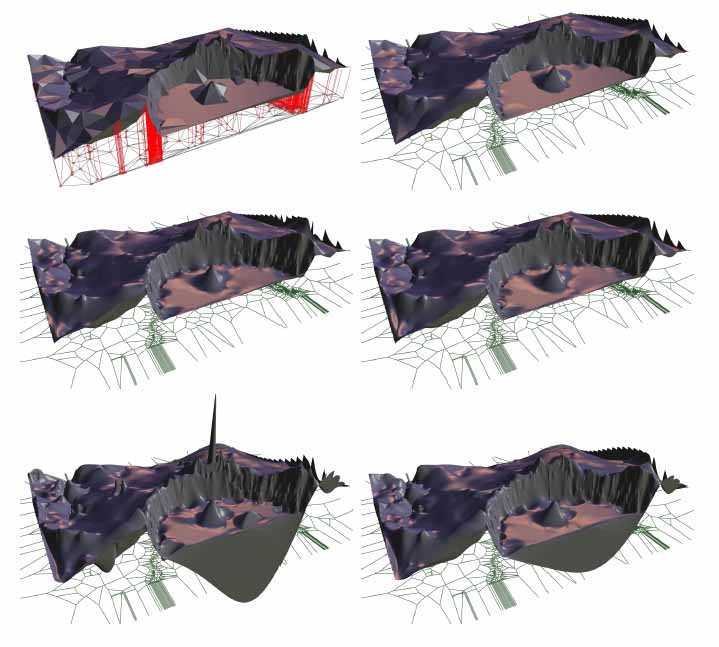 Issues and implementation of C1 and C2 natural neighbor
interpolation.
Issues and implementation of C1 and C2 natural neighbor
interpolation.Bobach, Bertram, Umlauf
In: G. Bebis et al. (eds.), Advances in Visual Computing, Part II, Springer-Verlag, 186-195, 2006.
Smooth local coordinates have been
proposed by Hiyoshi and Sugihara 2000 to improve the
classical Sibson’s and Laplace coordinates. These
smooth local coordinates are computed by integrating
geometric quantities over weights in the power
diagram. In this paper we describe how to
efficiently& implement the Voronoi based C2 local coordinates. The
globally C2 interpolant that Hiyoshi
and Sugihara presented in 2004 is then compared to
Sibson’s and Farin’s C1 interpolants when
applied to scattered data interpolation.
Available formats: pdf
Citation: BibTeX
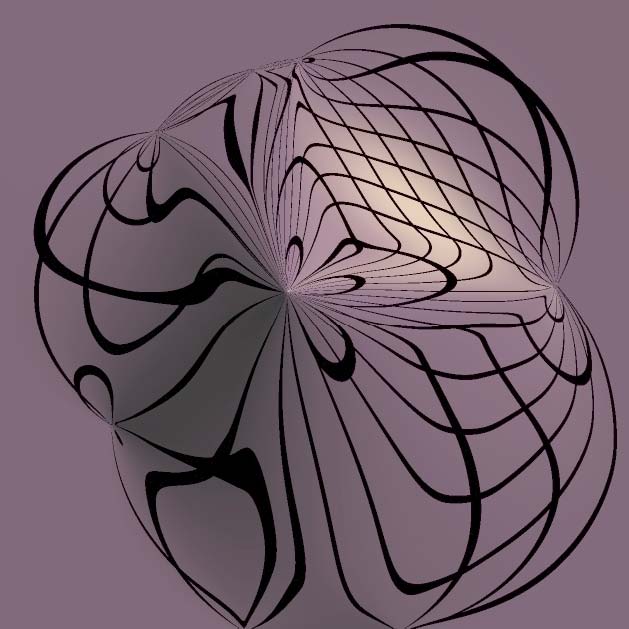 Natural
neighbor
interpolation
and order of continuity.
Natural
neighbor
interpolation
and order of continuity. Bobach, Umlauf
In: H. Hagen, A. Kerren, P. Dannenmann (eds.), GI Lecture Notes in Informatics, Visualization of Large and Unstructured Data Sets, 69-86, 2006.
In this paper we
give a survey on natural neighbor based interpolation, a
class of local scattered data interpolation schemes that
define their support on natural neighbors in the Voronoi
diagram of the input data sites. We discuss the existing
work with respect to common aspects of scattered data
interpolation and focus on smoothness of the
interpolant.
Available formats: pdf
Citation: BibTeX
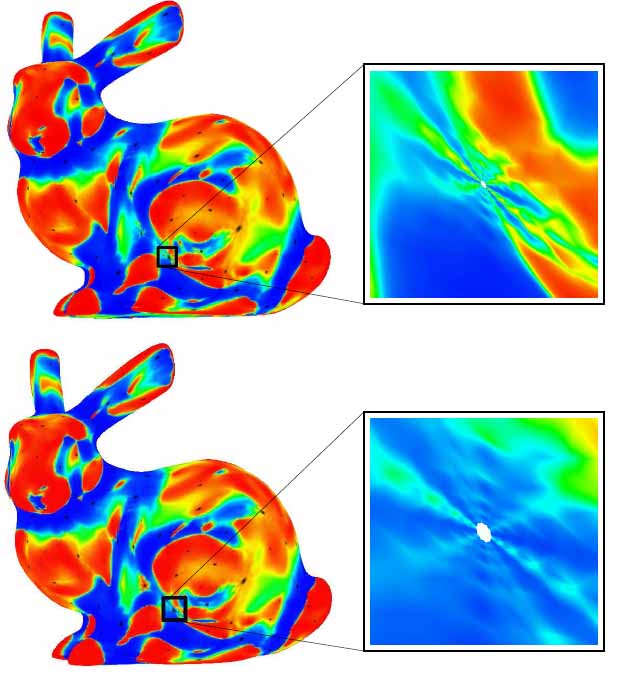 Controlling a subdivision
tuning method.
Controlling a subdivision
tuning method.Ginkel, Umlauf
In: A. Cohen, J.-L. Merrien, L.L. Schumaker (eds.), Curve and Surface Fitting, 170-179, 2006.
In this paper the
problem of curvature behavior around extraordinary
points of a Loop subdivision surface is addressed. For
subdivision surfaces, configurations of the initial
control net exist in which neither the elliptic nor the
hyperbolic component of the initial control net becomes
dominant. This leads to so-called hybrid shapes which
often cause visible artifacts. A solution to this
problem is to split it into two parts: first an
eigenvalue tuning to allow for bounded Gauss curvature
with arbitrary sign and, second, an eigencoefficient
tuning to avoid hybrid shapes. The techniques for
eigencoefficient tuning will now be analyzed in detail.
The analysis allows to quantify the difference between
the original and the modified surfaces. Additionally,
extensions to the eigencoefficient tuning techniques are
given to solve various problems that might be imposed by
the topology of the initial control net.
Available formats: pdf
Citation: BibTeX
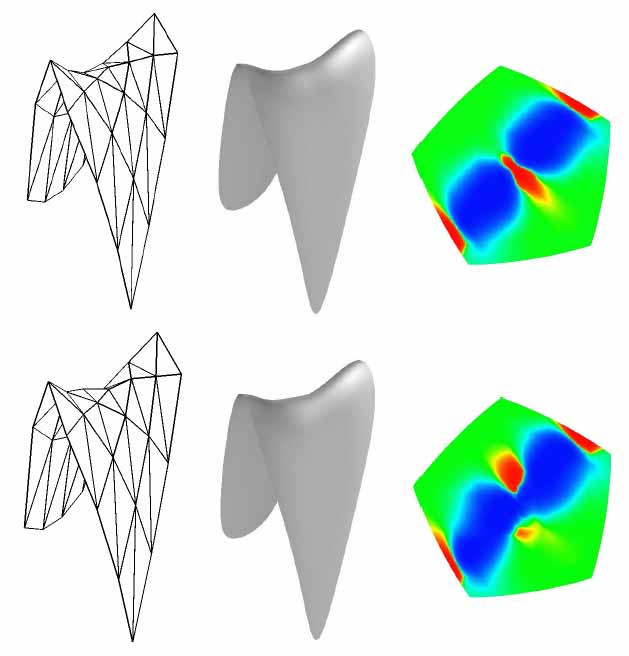 Loop
subdivision with curvature control.
Loop
subdivision with curvature control. Ginkel, Umlauf
In: K. Polthier, A. Sheffer (eds.), Eurographics Symposium on Geometry Processing, Eurographics Association, 163-171, 2006.
In this paper the
problem of curvature behavior around extraordinary
points of a Loop subdivision surface is addressed. A
variant of Loop’s algorithm with small stencils is used
that generates surfaces with bounded curvature and
prescribed elliptic or hyperbolic behavior. We present
two different techniques that avoid the occurrence of
hybrid configurations, so that an elliptic or hyperbolic
shape can be guaranteed. The first technique uses a
symmetric modification of the initial control-net to
avoid hybrid shapes in the vicinity of an extraordinary
point. To keep the difference between the original and
the modified mesh as small as possible the changes are
formulated as correction stencils and spread to a finite
number of subdivision steps. The second technique is
based on local optimization in the frequency domain. It
provides more degrees of freedom and so more control
over the global shape.
Available formats: pdf
Citation: BibTeX
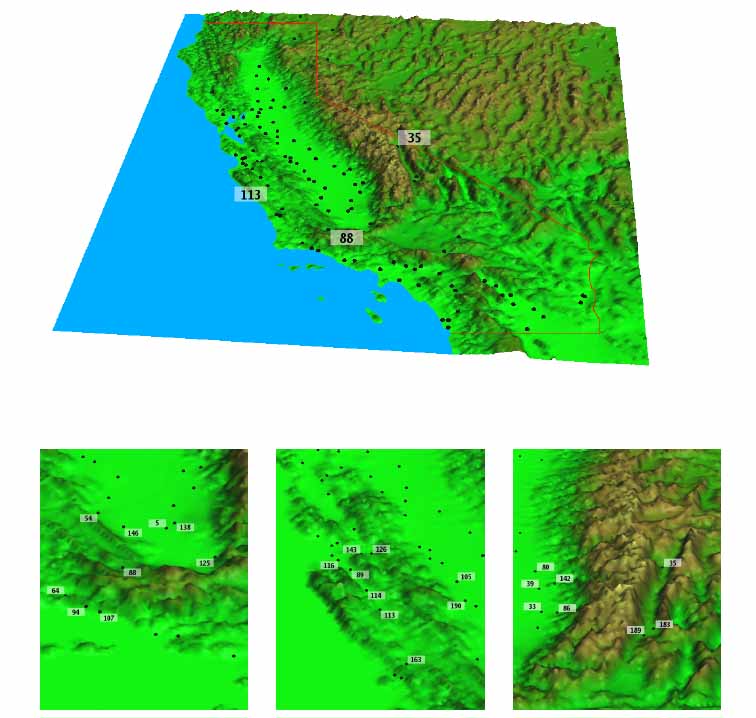 Topographic
distance
functions for interpolation of meteorological data.
Topographic
distance
functions for interpolation of meteorological data.Lehner, Umlauf, Hamann, Ustin
In: H. Hagen, A. Kerren, P. Dannenmann (eds.), GI Lecture Notes in Informatics, Visualization of Large and Unstructured Data Sets, 119-131, 2006.
The reference
evapotranspiration ET0 is an important meteorological
quantity in agriculture and water resource management.
It is usually estimated from other meteorological
quantities measured at weather stations. To estimate ET0
at an arbitrary geographical position these quantities
must be interpolated. The Center for Spatial
Technologies And Remote Sensing (CSTARS) at UC Davis
uses the DayMet approach for this task.
We discuss some inconsistencies within the DayMet approach and suggest improvements. One significant problem of DayMet is the lack of consideration of terrain topography. We define new distance functions that are elevation-dependent and show preliminary results of the comparison of the classic and the improved DayMet approach.
We discuss some inconsistencies within the DayMet approach and suggest improvements. One significant problem of DayMet is the lack of consideration of terrain topography. We define new distance functions that are elevation-dependent and show preliminary results of the comparison of the classic and the improved DayMet approach.
Available formats: pdf
Citation: BibTeX
Parametrizations for triangular Gk spline surfaces of low degree.
Prautzsch, Umlauf
ACM Transactions on Graphics, 25(4), 1281-1293, 2006.
In this paper, we
present regularly parametrized Gk
free form spline surfaces that extend box and half-box
splines over regular triangular grids. The polynomial
degree of these splines is max{4k+1; floor(3k/2 +1)}, where r \in N can be
chosen arbitrarily and determines the flexibility at extraordinary
points. The Gk
splines presented in this paper depend crucially on
low-degree (re-)parametrizations of piecewise polynomial
hole fillings. The explicit construction of such
parametrizations forms the core of this paper and we
present two classes of singular and regular
parametrizations. Also we show how to build box and
half-box spline surfaces of arbitrarily high smoothness
with holes bounded by only n patches in principle.
Available formats: pdf
Citation: BibTeX
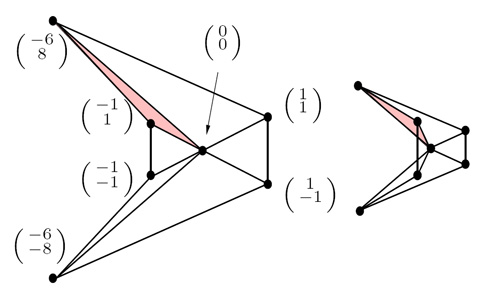 On normals and control nets.
On normals and control nets.Ginkel, Peters, Umlauf
In: R. Martin, H. Bez, M. Sabin (eds.): The Mathematics of Surfaces XI, Springer-Verlag, 2005, 233-239.
This paper characterizes when the normals of a spline curve or spline surface lie in the more easily computed cone of the normals of the segments of the spline control net.
Available formats: pdf
Citation: BibTeX
A
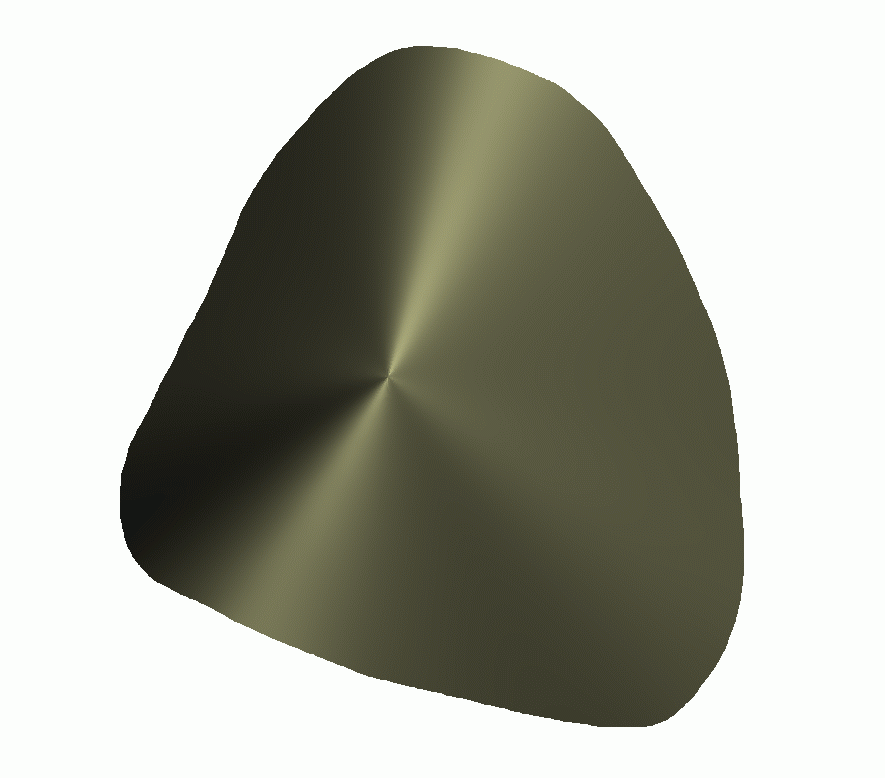 nalysis
and tuning of subdivision schemes.
nalysis
and tuning of subdivision schemes.Umlauf
In: B. Jüttler (ed.), Proceedings of Spring Conference on Computer Graphics SCCG 2005, ACM Press, 33-40, 2005.
This paper surveys the
current state in analyzing and tuning of subdivision
algorithms. These two aspects of subdivision algorithms
are very much intertwined with the differential geometry
of the subdivision surface. This paper deals with the
interconnection of these different aspects of
subdivision algorithms and surfaces. The principal idea
for the analysis of a subdivision algorithm dates back
to the late 70s although the overall technique is only
well understood since the early 90s. Most subdivision
algorithms are analyzed today but the proofs involve
time consuming computations. Only recently simple proofs
for a certain class of subdivision algorithms were
developed that are based on geometric reasoning. This
allows for easier smoothness proofs for new developed or
tuned subdivision algorithms.
The analysis of the classical algorithms, such Catmull-Clark, Loop, etc., shows that the subdivision surfaces at the extraordinary points are not as smooth as the rest of the surface. It was also shown that the subdivision surfaces of these classical algorithms cannot model certain basic shapes. One way to tune a stationary subdivision algorithms to overcome this problem is to drop the stationarity while at the same time using the smoothness proof of the stationary algorithms.
The analysis of the classical algorithms, such Catmull-Clark, Loop, etc., shows that the subdivision surfaces at the extraordinary points are not as smooth as the rest of the surface. It was also shown that the subdivision surfaces of these classical algorithms cannot model certain basic shapes. One way to tune a stationary subdivision algorithms to overcome this problem is to drop the stationarity while at the same time using the smoothness proof of the stationary algorithms.
Available formats: pdf
Citation: BibTeX
 Post-processing
polygonal
voxel data from numerical simulation.
Post-processing
polygonal
voxel data from numerical simulation. Bobach, Umlauf
Interner Bericht 332/04, Fachbereich Informatik, TU Kaiserslautern, 2004.
Many
applications dealing with geometry acquisition and
processing produce polygonal meshes that carry
artifacts like discretization noise. While there are
many approaches to remove the artifacts by smoothing
or filtering the mesh, they are not tailored to any
specific application demanding certain restrictive
constraints. We show how to incorporate smoothing
schemes based on the general Laplacian approximation
to process the results of flow simulation in car
manufacturing.
In the presented application setting the major restrictions come from the bounding volume of the flow simulation, the so-called installation space. In particular, clean mesh regions (without noise) should not be smoothed while at the same time the installation space must not be violated by the smoothing of the noisy mesh regions. Additionally, aliasing effects at the boundary between clean and noisy mesh regions must be prevented. To address the fact that the meshes come from flow simulation, the presented method is versatile enough to preserve their exact volume and to apply anisotropic filters using the flow information.
In the presented application setting the major restrictions come from the bounding volume of the flow simulation, the so-called installation space. In particular, clean mesh regions (without noise) should not be smoothed while at the same time the installation space must not be violated by the smoothing of the noisy mesh regions. Additionally, aliasing effects at the boundary between clean and noisy mesh regions must be prevented. To address the fact that the meshes come from flow simulation, the presented method is versatile enough to preserve their exact volume and to apply anisotropic filters using the flow information.
Available formats: pdf
Citation: BibTeX
A technique for verifying the smoothness of subdivision schemes.
Umlauf
In: M.L. Lucian, M. Neamtu (eds.), Geometric Modeling and Computing: Seattle 2003, Nashboro Press, 513-521, 2004.
In recent years,
subdivision schemes for surfaces of arbitrary topology
were developed that do not generalize box-splines
subdivision schemes. Examples for this kind of
subdivision schemes are the sqrt(3)-scheme and certain
averaging schemes for triangular and hexahedral nets. In
order to analyze the smoothness of the limit surface, it
is necessary to know if its characteristic map is
regular and injective. For box-spline based schemes this
can be done based on the explicit piecewise polynomial
representation. In this paper, a general approach is
introduced that allows analyzing the characteristic map
even if no explicit representation is available. The
proposed technique requires that the first divided
differences schemes are scalar and use convex
combinations. Then simple geometric properties of the
sub-dominant eigenvectors of the subdivision matrix can
be used to prove regularity and injectivity of the
characteristic map for any valence. This is demonstrated
for a midpoint scheme for triangular nets.
Available formats: pdf
Citation: BibTeX
Computing curvature bounds for bounded curvature subdivision.
Peters, Umlauf
Computer Aided Geometric Design, 18 (5): 455-462, 2001.
For a stationary, affine
invariant, symmetric, linear and local subdivision
scheme that is C2
apart from the extraordinary point the curvature is
bounded if the square of the subdominant eigenvalue
equals the subsubdominant eigenvalue. This paper gives a
technique for quickly establishing an interval to which
the curvature is confined at the extraordinary point.
The approach factors the work into precomputed intervals
that depend only on the scheme and a mesh-specific
component. In many cases the intervals are tight enough
to be used as a test of shape-faithfulness of the given
subdivision scheme; i.e. if the limit surface in the
neighborhood of the extraordinary point of the
subdivision scheme is consistent with the geometry
implied by the input mesh.
Available formats: pdf
Citation: BibTeX
Triangular Gk splines.
Prautzsch, Umlauf
Interner Bericht Nr. 2001-8, Fakultät für Informatik, Universität Karlsruhe, 2001.
In this paper a new
approach is presented to construct piecewise polynomial
Gk-surfaces
of
arbitrary topology and smoothness order k>0 of degree O(k). This approach
generalizes some results presented in 1997 in CAGD and
in 1999 at the Saint-Malo conference, respectively. In
our construction only 4n
polynomial patches are needed to fill an n-sided hole in a
generalized Ck-(half-)box
spline
surface.
This
is
achieved
by
coalescing
certain
control
points
while
at
the
same
time
maintaining
a
regular
parametrization.
Gaussian and mean curvature of subdivision surfaces.
Peters, Umlauf
In: R. Cipolla, R. Martin (eds.), The Mathematics of Surfaces IX, Springer-Verlag, 59-69, 2000.
By explicitly
deriving the curvature of subdivision surfaces in the
extraordinary points, we give an alternative, more
direct account of the criteria necessary and sufficient
for achieving curvature continuity than earlier
approaches that locally parametrize the surface by
eigenfunctions. The approach allows us to rederive and
thus survey the important lower bound results on
piecewise polynomial subdivision surfaces by Prautzsch,
Reif, Sabin and Zorin, as well as explain the beauty of
curvature continuous constructions like Prautzsch’s. The
parametrization neutral perspective gives also
additional insights into the inherent constraints and
stiffness of subdivision surfaces.
Available formats: pdf
Citation: BibTeX
A G1 and a G2 subdivision scheme for triangular nets.

Prautzsch, Umlauf
International Journal on Shape Modelling, 6(1): 21-35, 2000.
In this article we
improve the butterfly and Loop's algorithm. As a result
we obtain subdivision algorithms for triangular nets
which can be used to generate G1-
and G2-surfaces,
respectively.
Citation: BibTeX
Analyzing the characteristic map of triangular subdivision schemes.
Umlauf
Constructive Approximation, 16(1): 145-155, 2000.
Tools for the
analysis of generalized triangular box spline
subdivision schemes are developed. For the first time
the full analysis of Loop's algorithm can be carried out
with these tools.
Available formats: pdf
Citation: BibTeX
Glatte Freiformflächen und optimierte Unterteilungsalgorithmen.
Umlauf
April 1999. Verlag Shaker, Aachen, 1999.
In German.
Triangular G2- splines.
Prautzsch ,Umlauf
In: P.-L. Laurent, P. Sablonniere, L.L. Schumaker (eds.), Curve and Surface Design, Vanderbilt University Press, 335-342, 1999.
We introduce curvature
continuous regular free-form surfaces with triangular
control nets. These surfaces are composed of quartic box
spline surfaces and are piecewise polynomial multisided
patches of total degree 8 which minimize some energy
integral. The Bézier nets can be computed efficiently
form the spline control net by some fixed masks, i.e.
matrix multiplications.
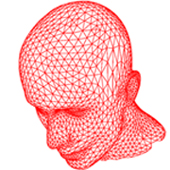 |
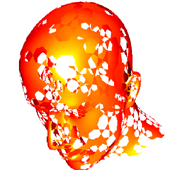 |
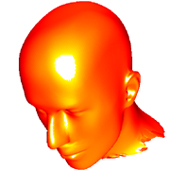 |
Available formats: pdf
Citation: BibTeX
Improved triangular subdivision schemes.
Prautzsch, Umlauf
In: F.-E. Wolter and N.M. Patrikalakis (eds.), Proceedings of the CGI '98, Hannover, 626-632, 1998.
In this article we improve the butterfly and Loop’s algorithm. As a result we obtain subdivision algorithms for triangular nets which can be used to generate G1- and G2-surfaces, respectively.
Available formats: pdf
Citation: BibTeX
Konstruktion von Gk-Flächen.
Umlauf
In: T. Ertl (ed.), "Trends und Höhepunkte der Graphischen Datenverarbeitung", Gesellschaft für Informatik, FA 4.1, Bonn, 1998.
In German.
A G2-subdivision algorithm.
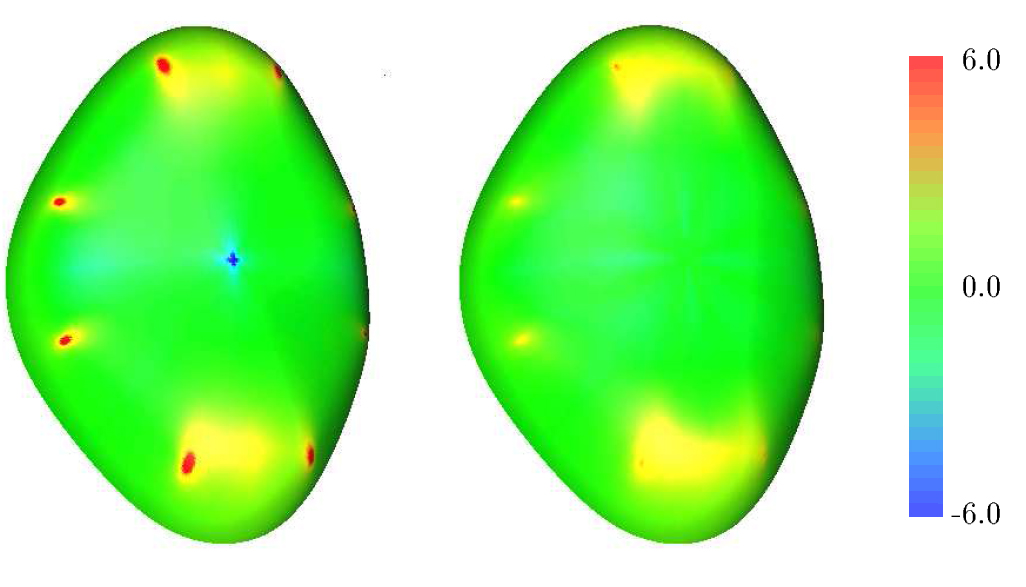
Prautzsch, Umlauf
Computing, 13: 217-224, 1998.
In this paper we
present a method to optimize the smoothness order of
subdivision algorithms generating surfaces of arbitrary
topology. In particular we construct a
subdivision algorithm with some negative weights
producing G2-surfaces.
These surfaces are piecewise bicubic and
are flat at their extraordinary points. The underlying
ideas can also be used to improve the smoothness order
of subdivision algorithms for surfaces of higher degree
or triangular nets.
Available formats: pdf
Citation: BibTeX
| © Georg Umlauf | Last modified: 25.09.2019 |